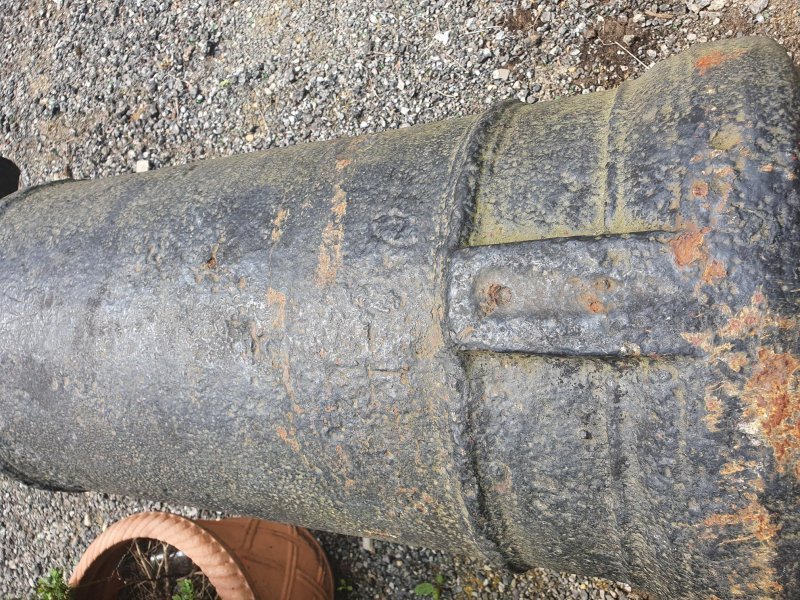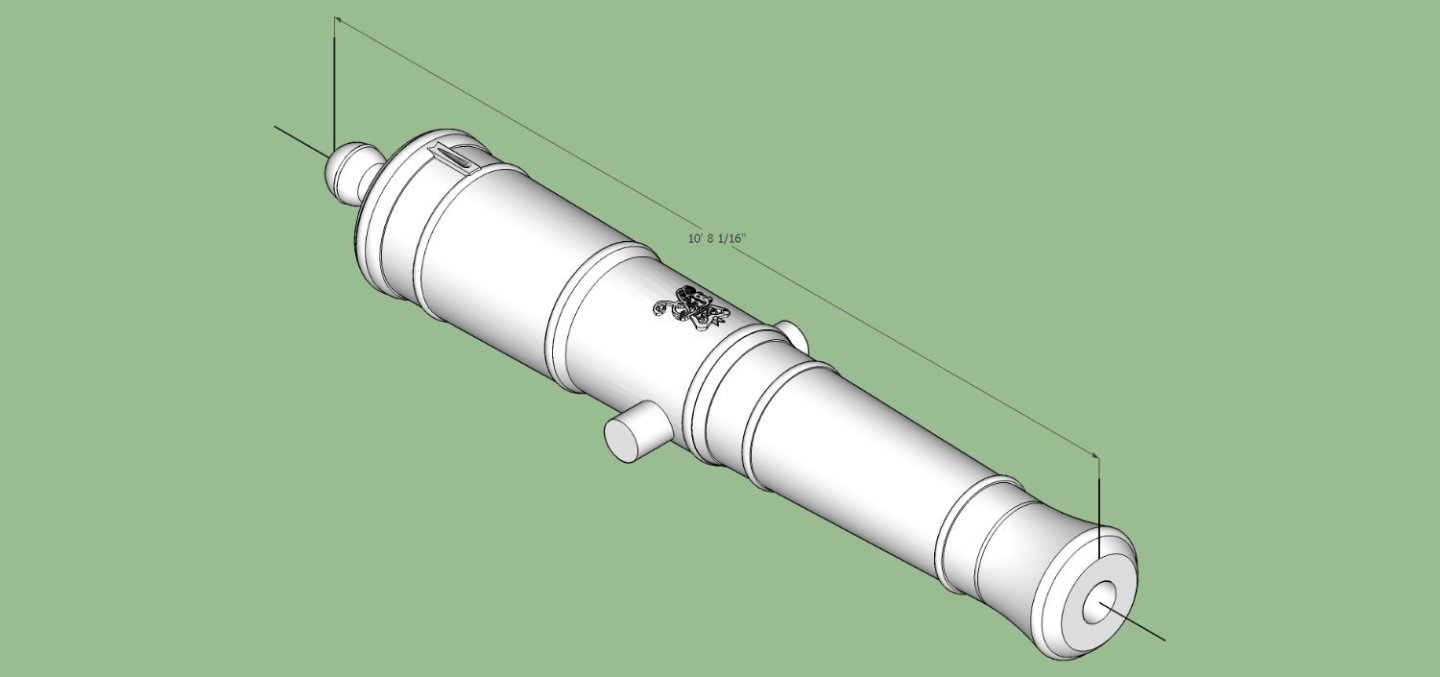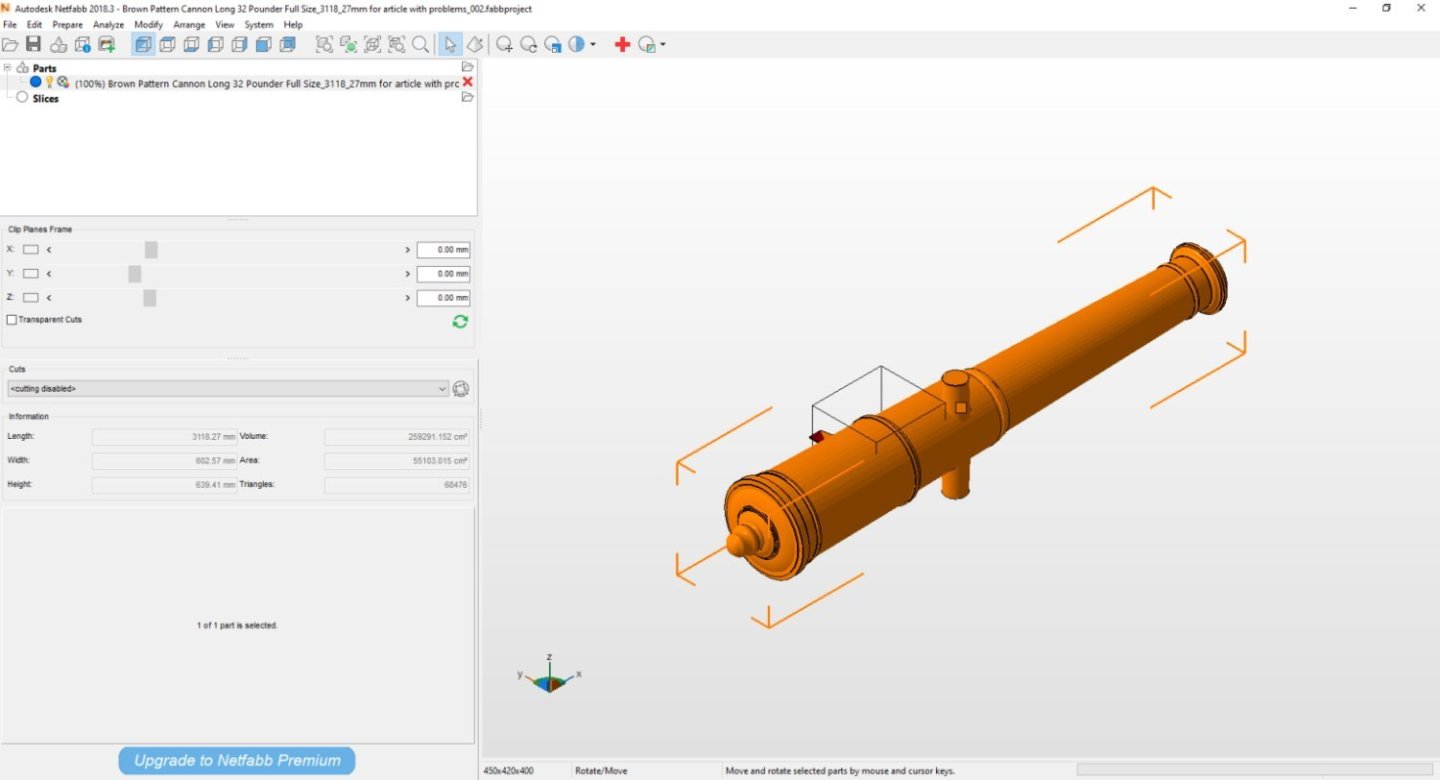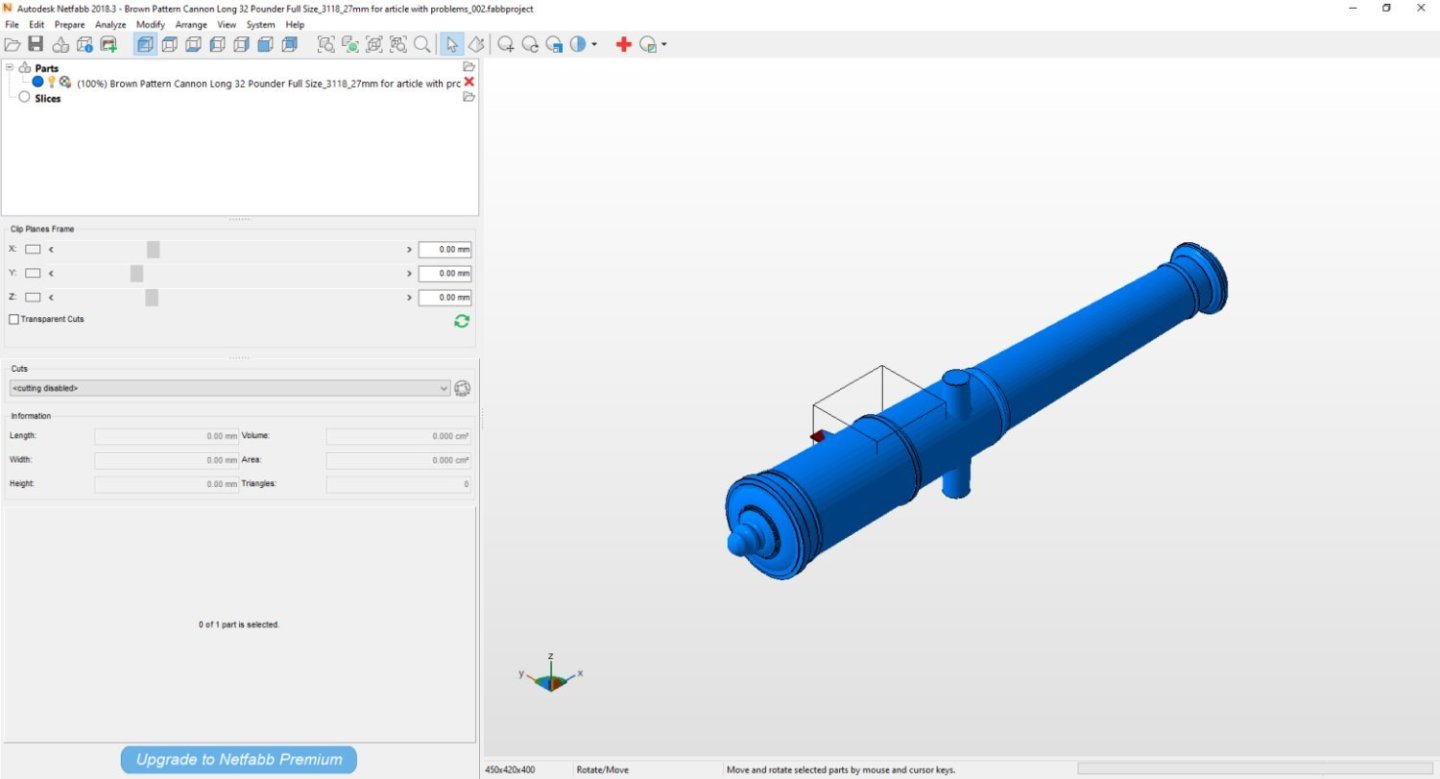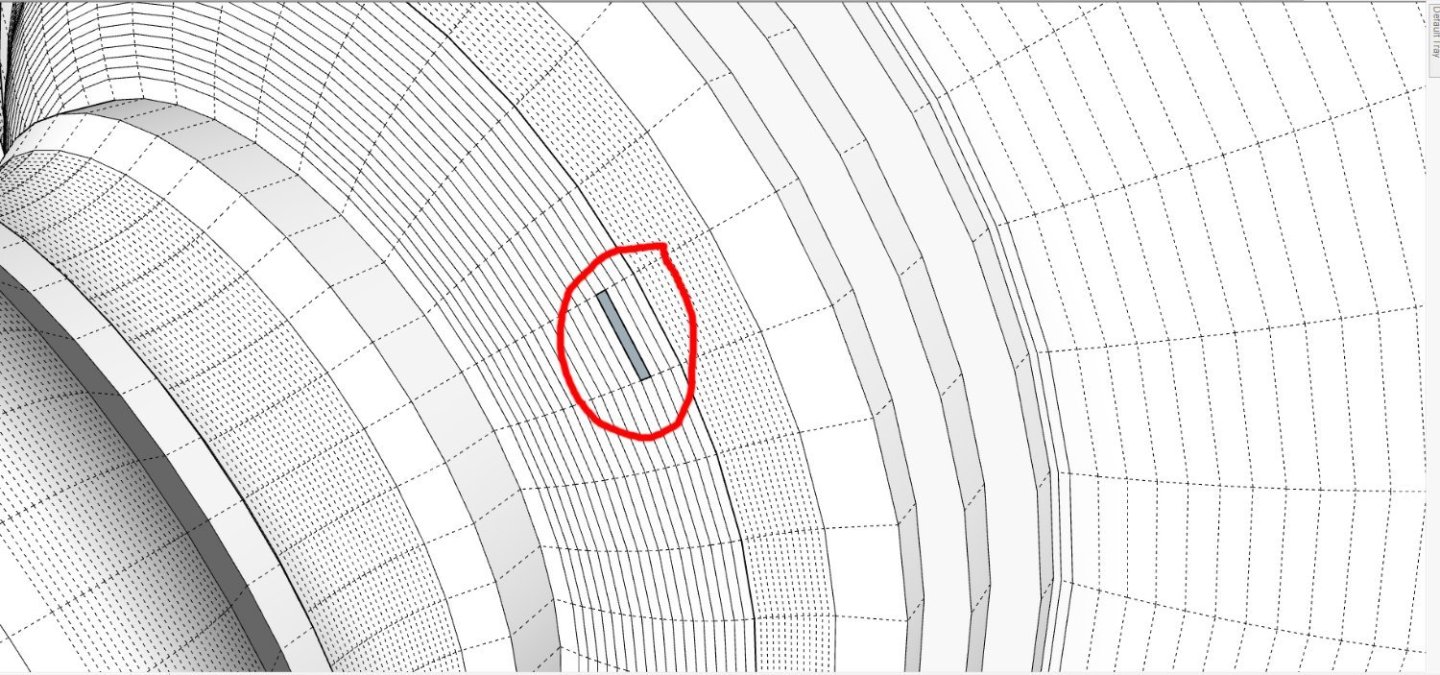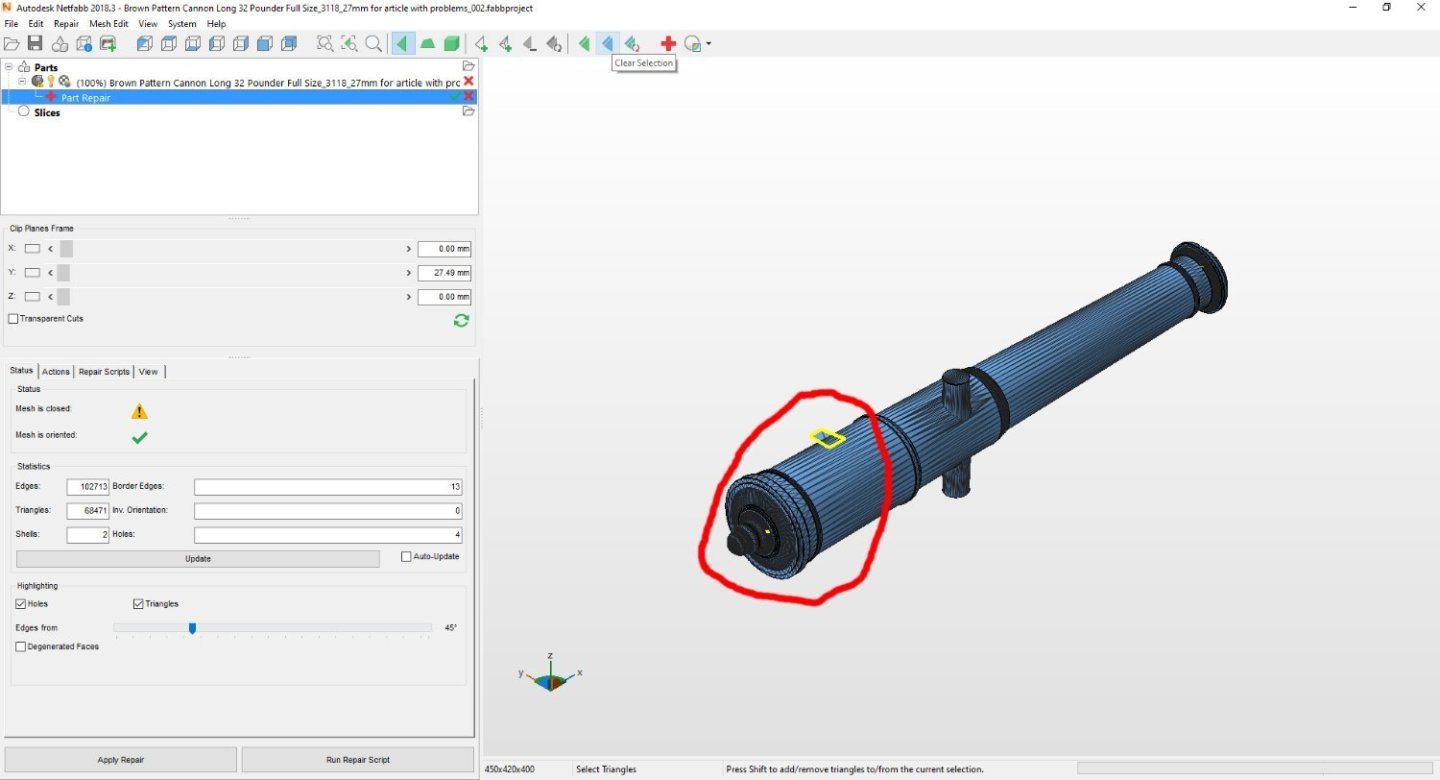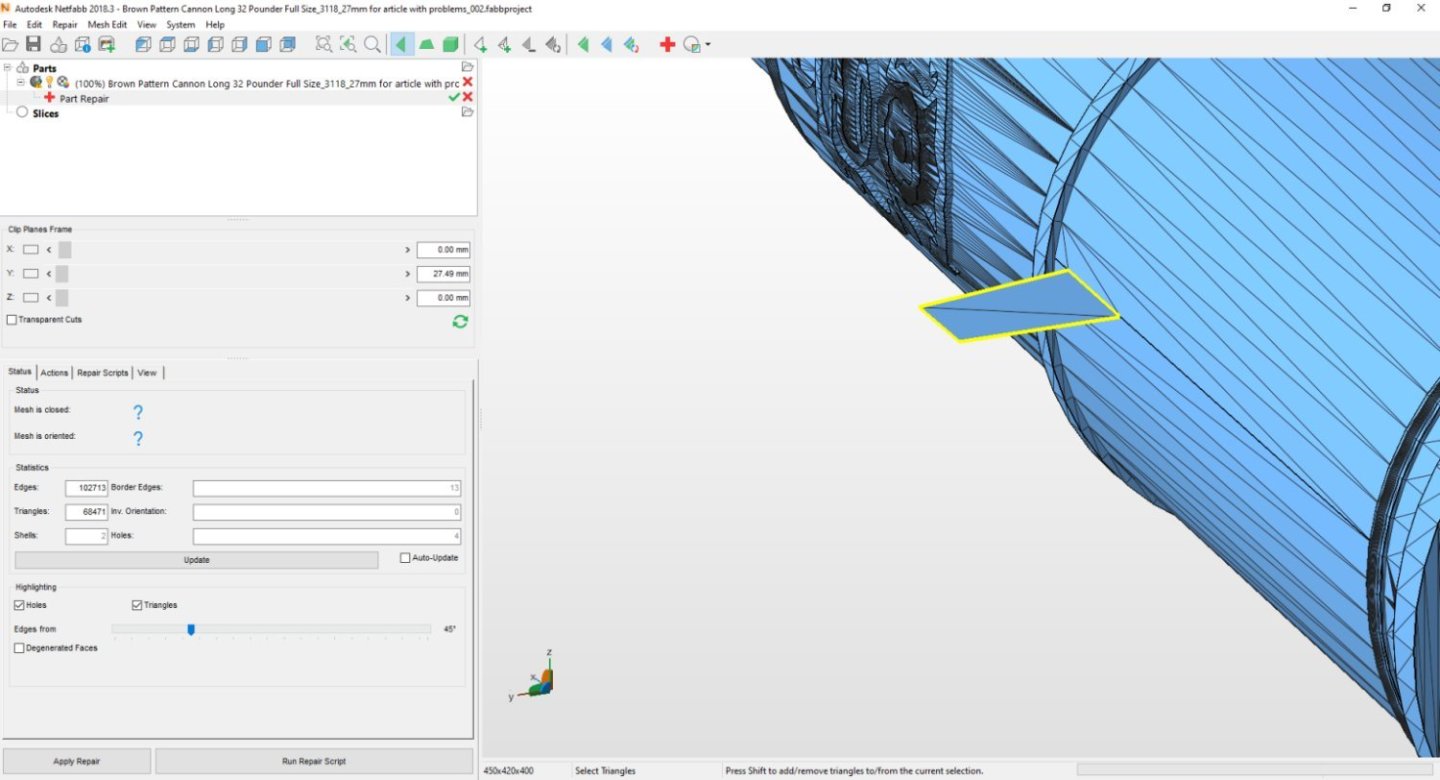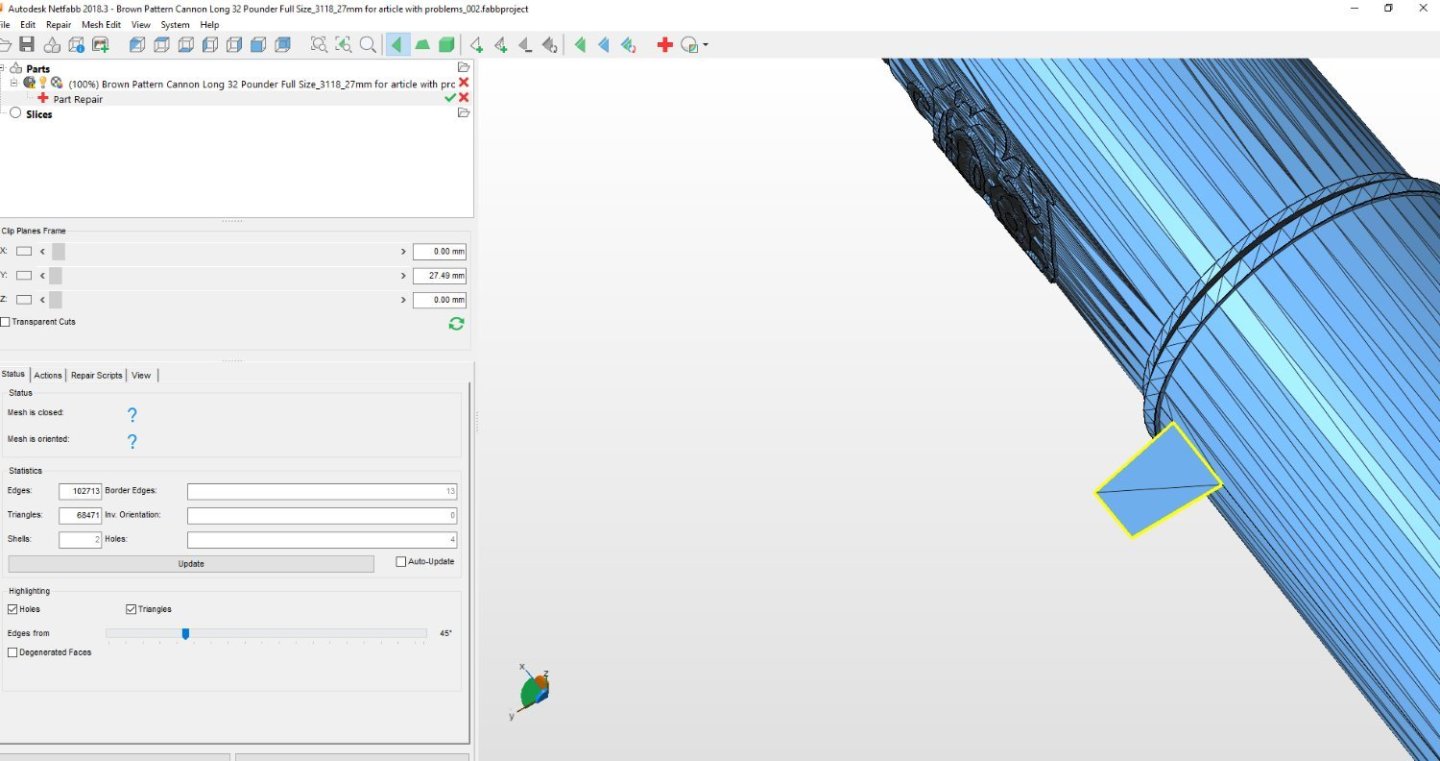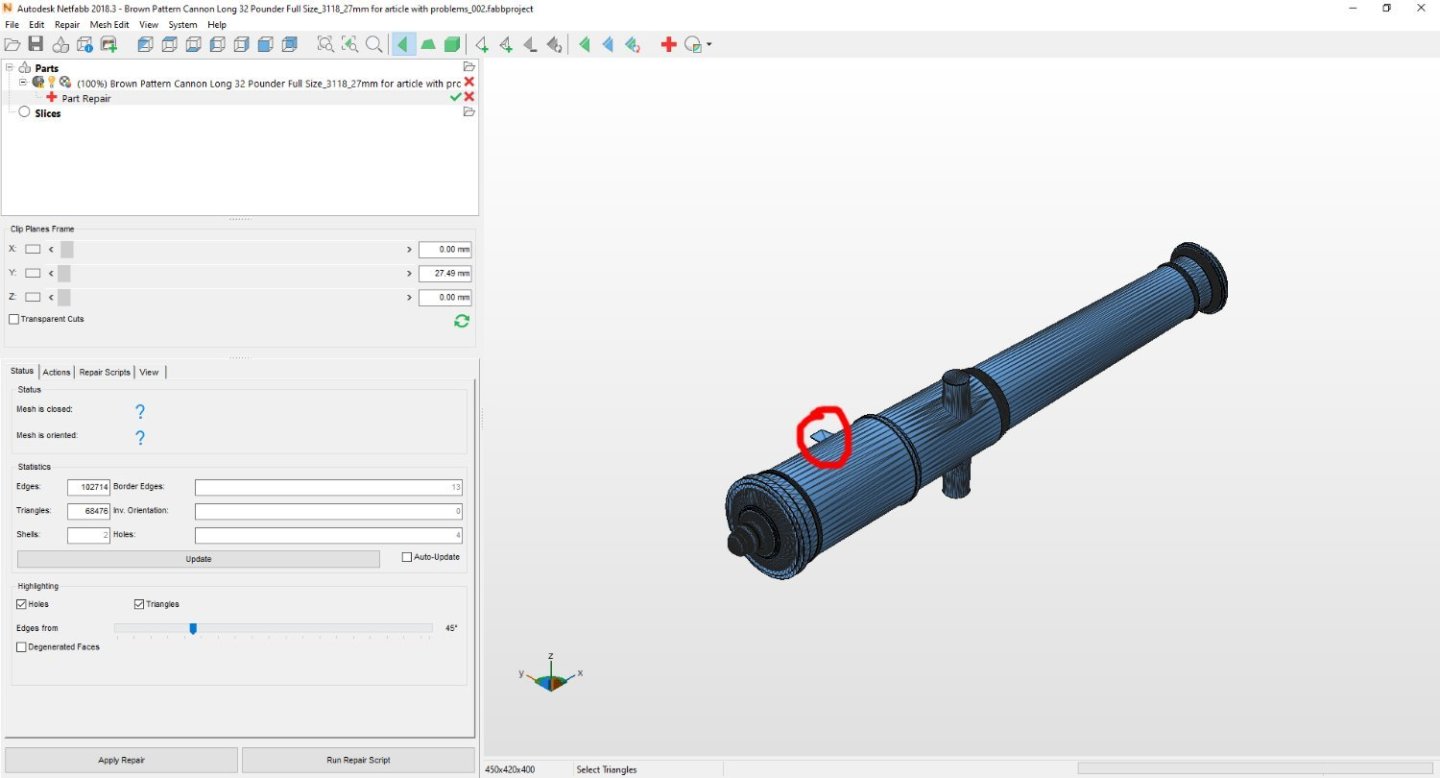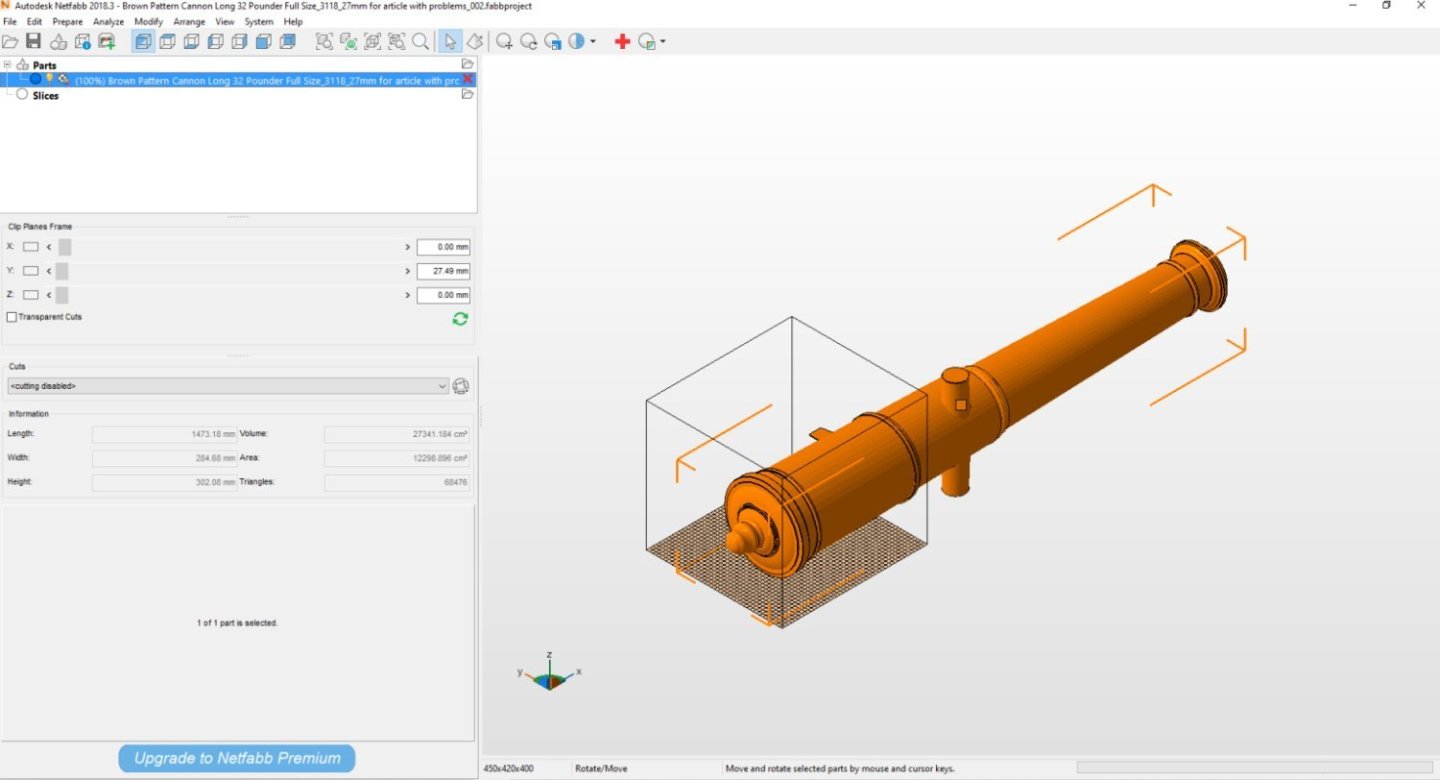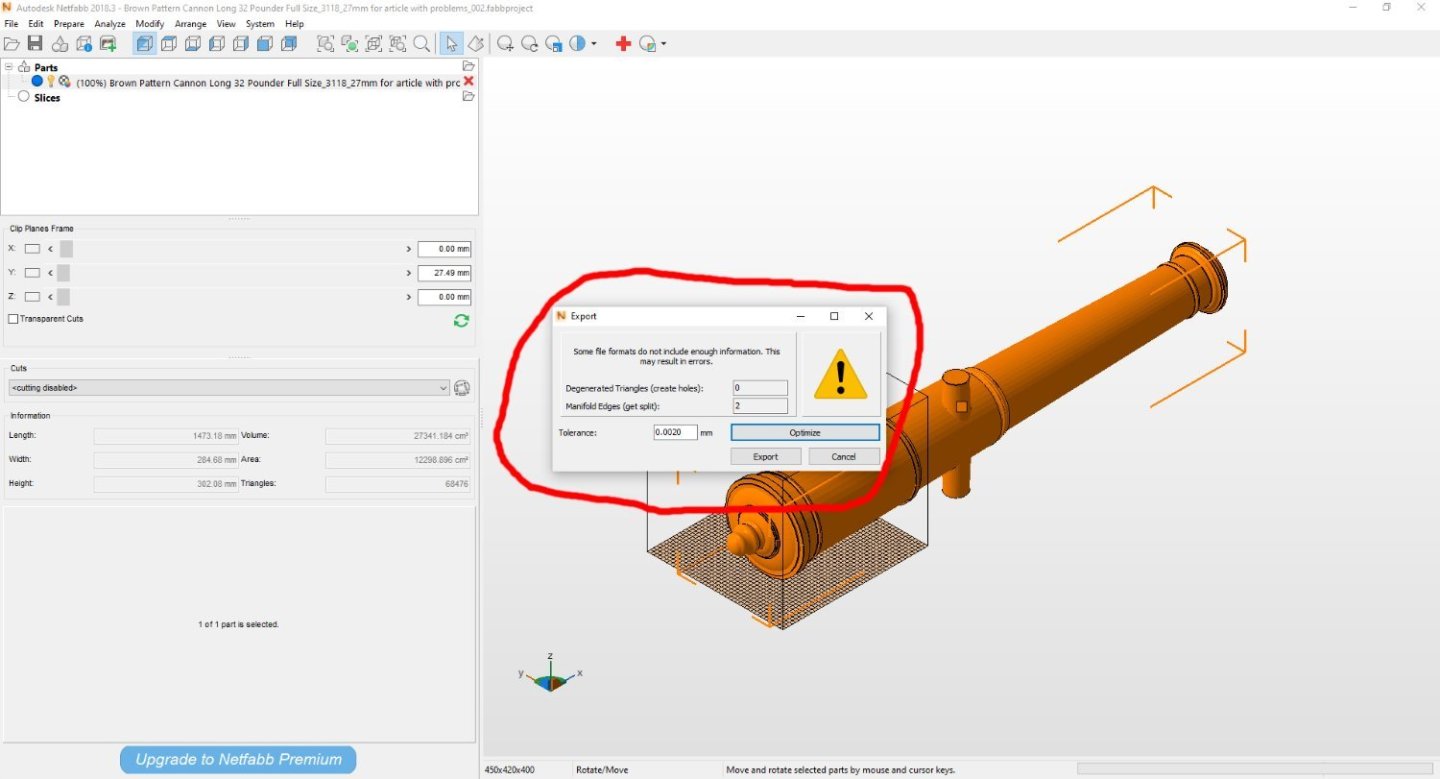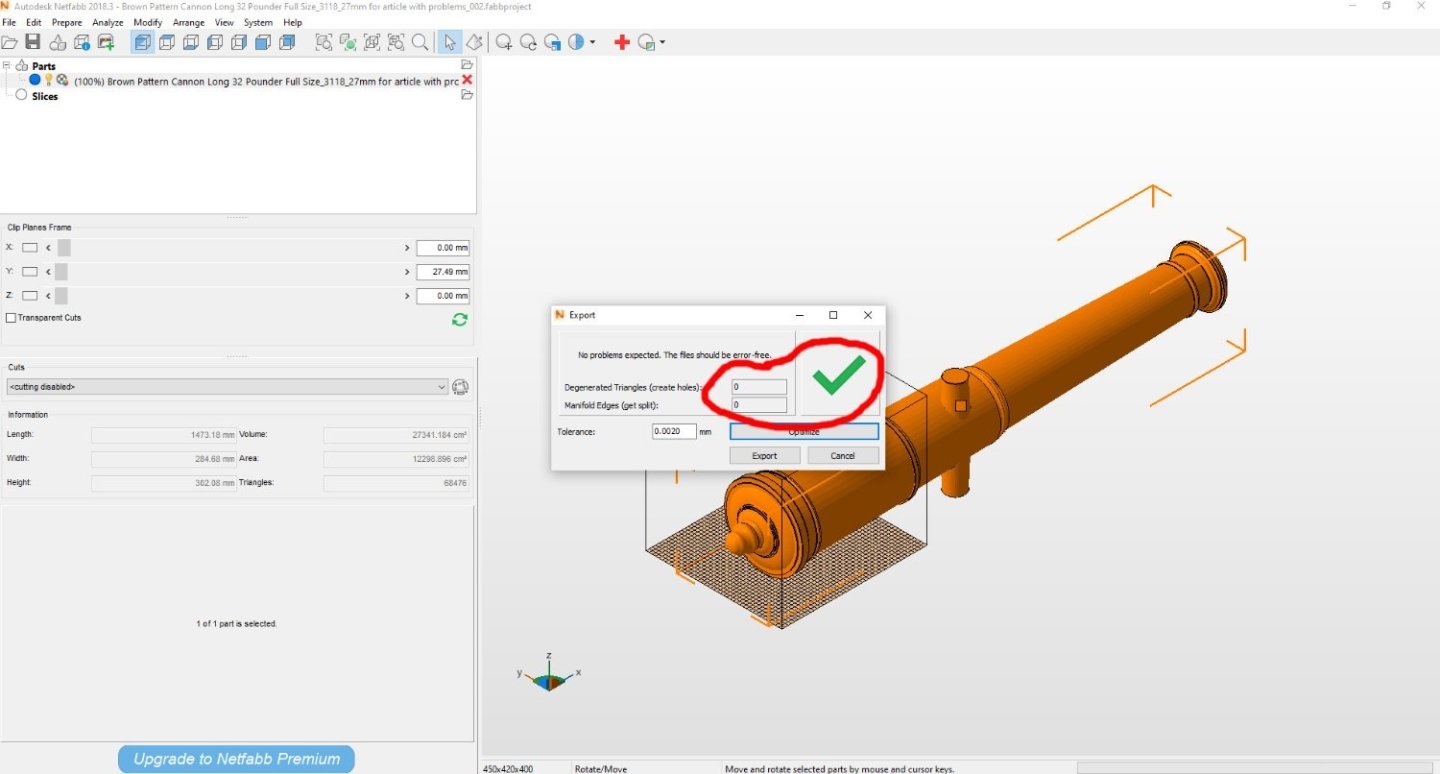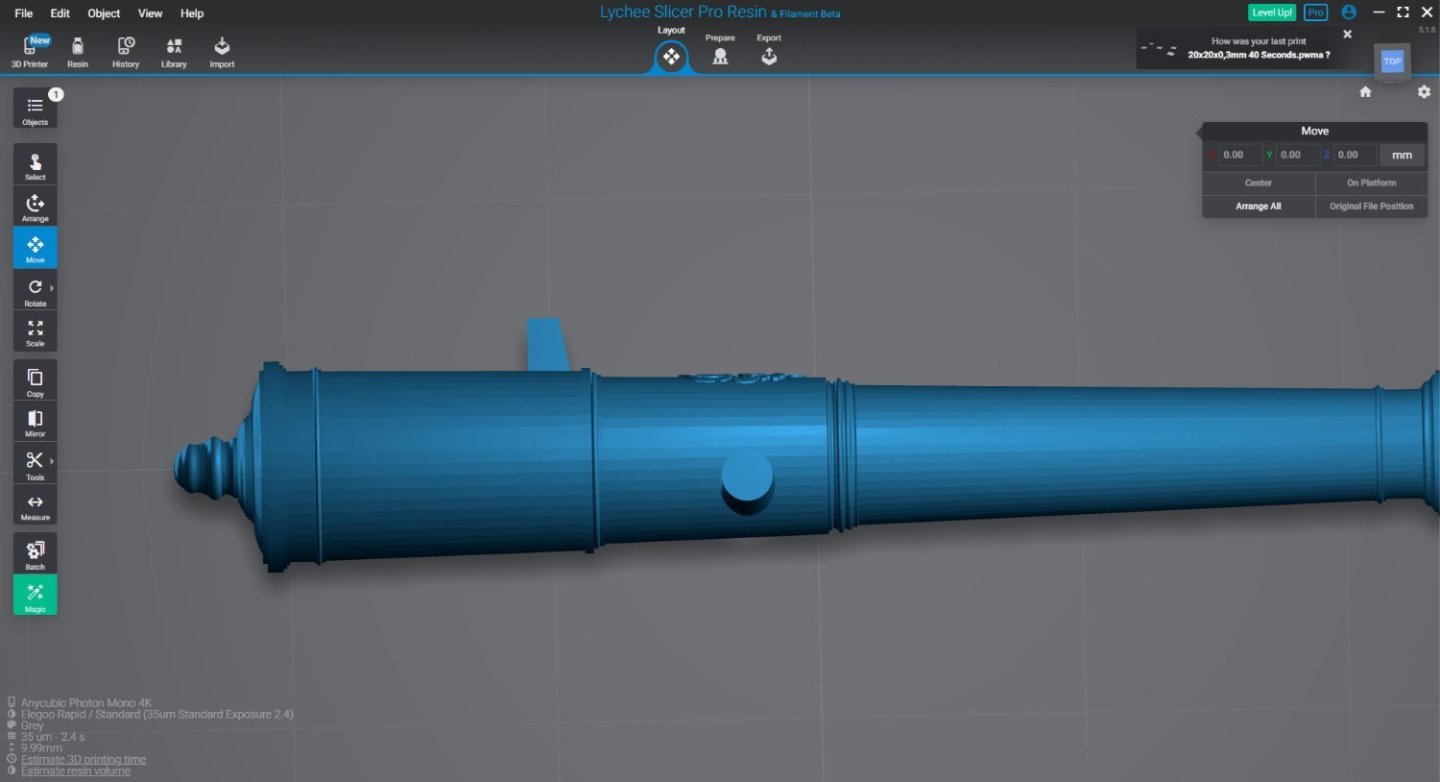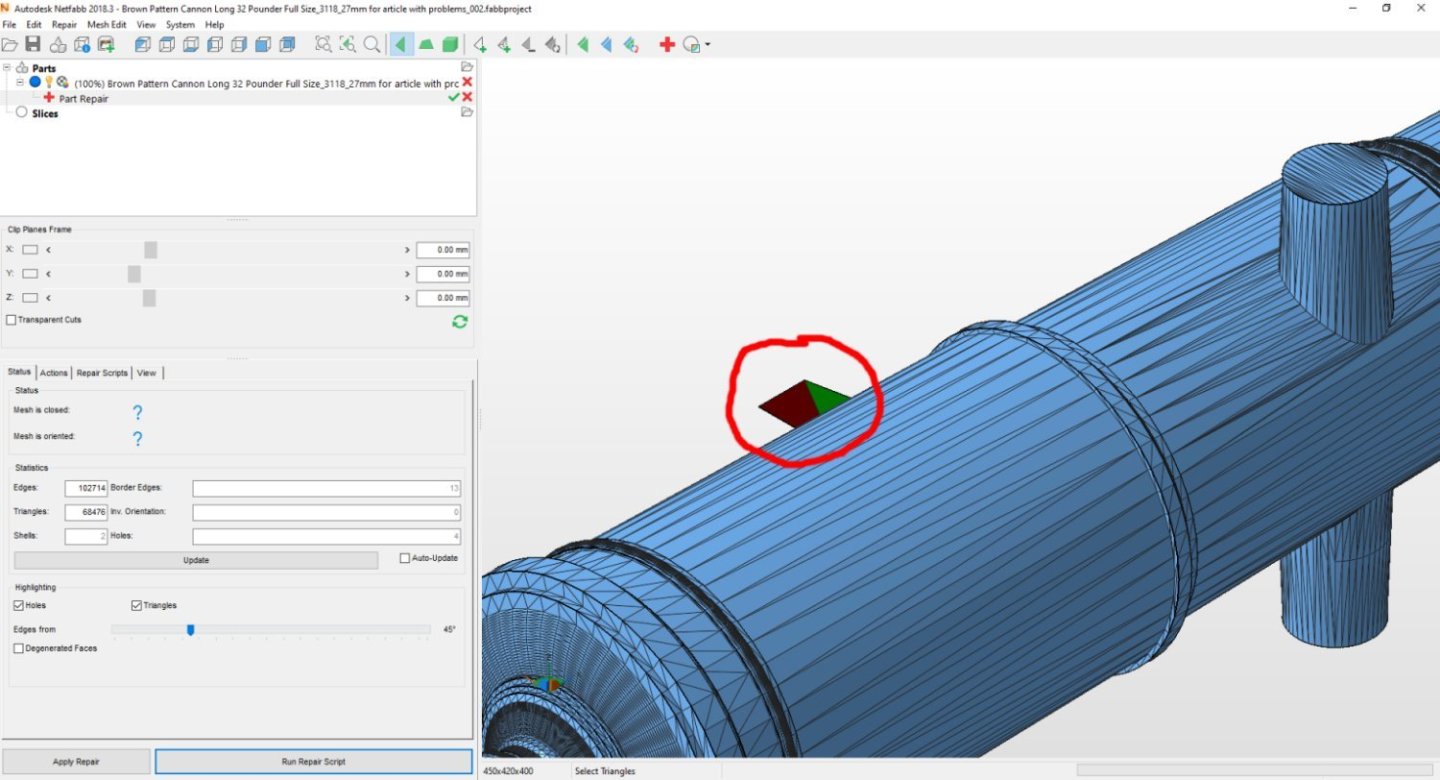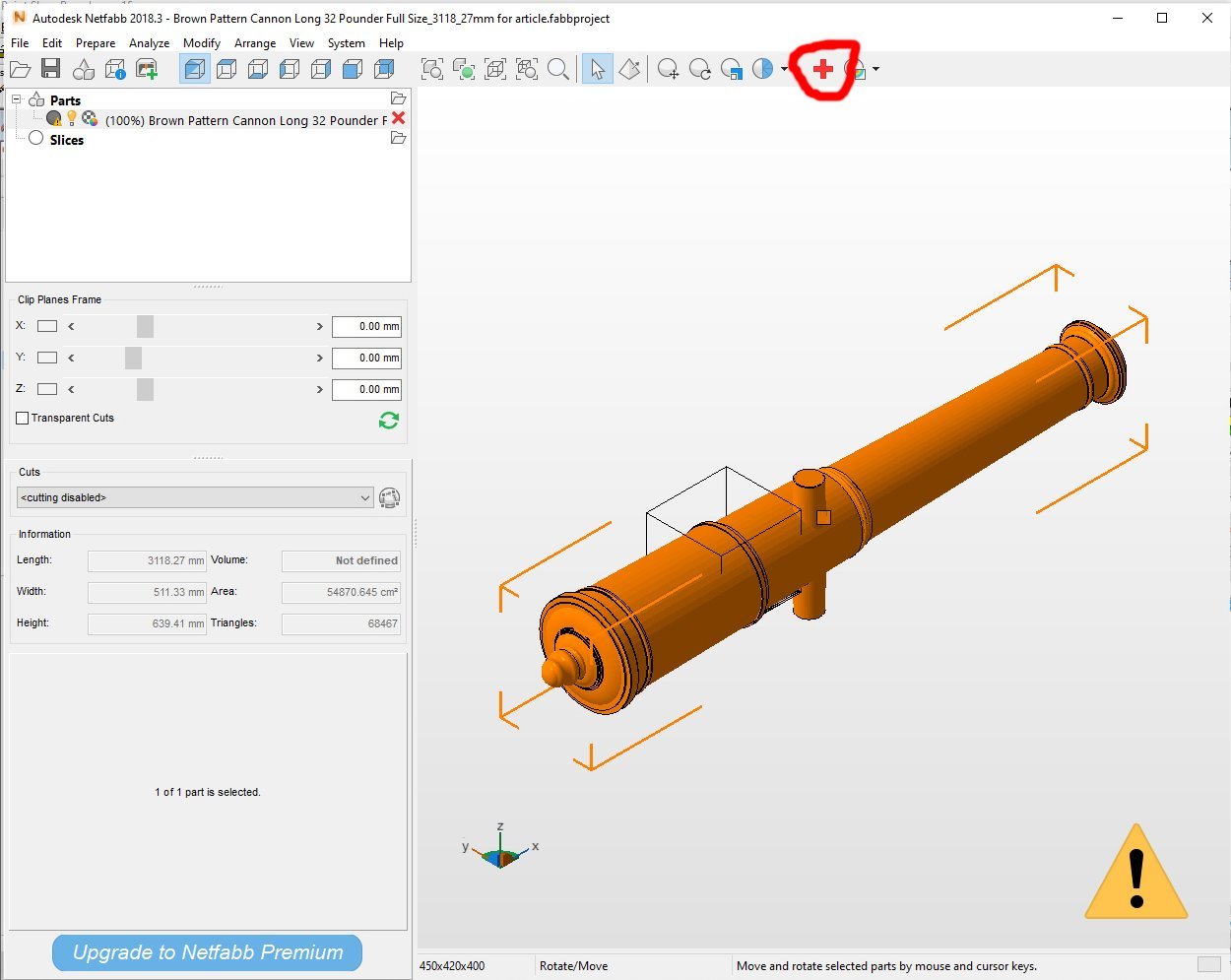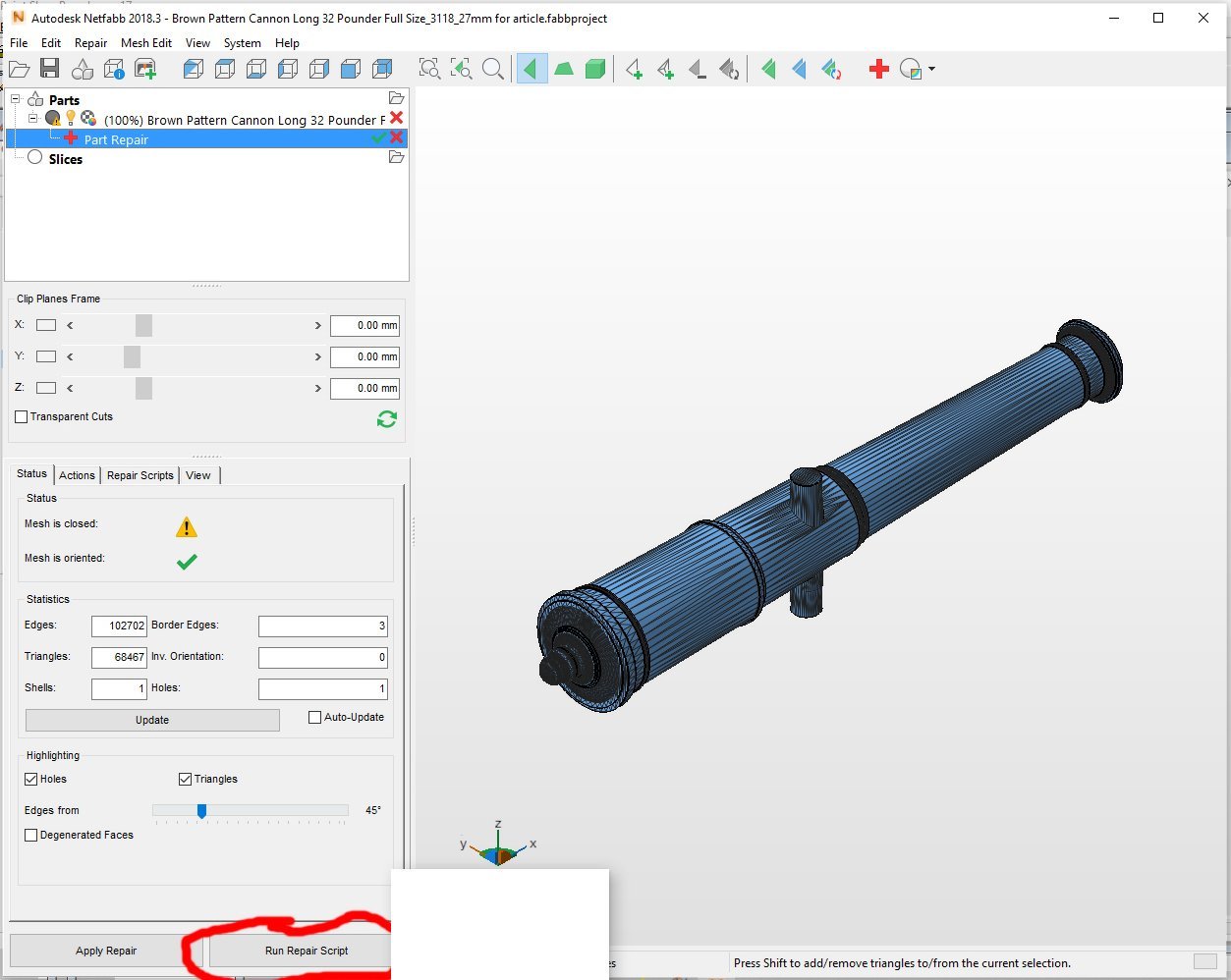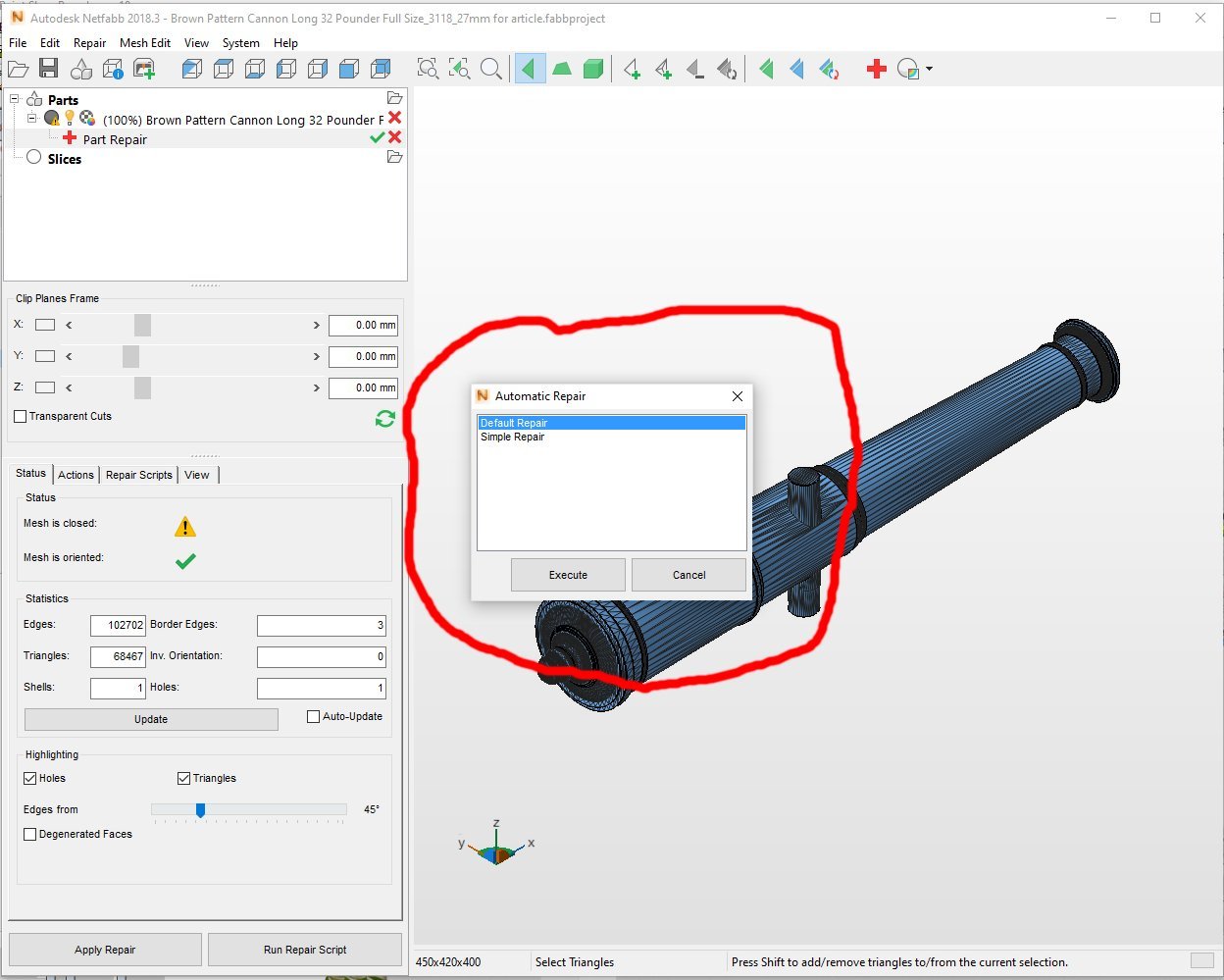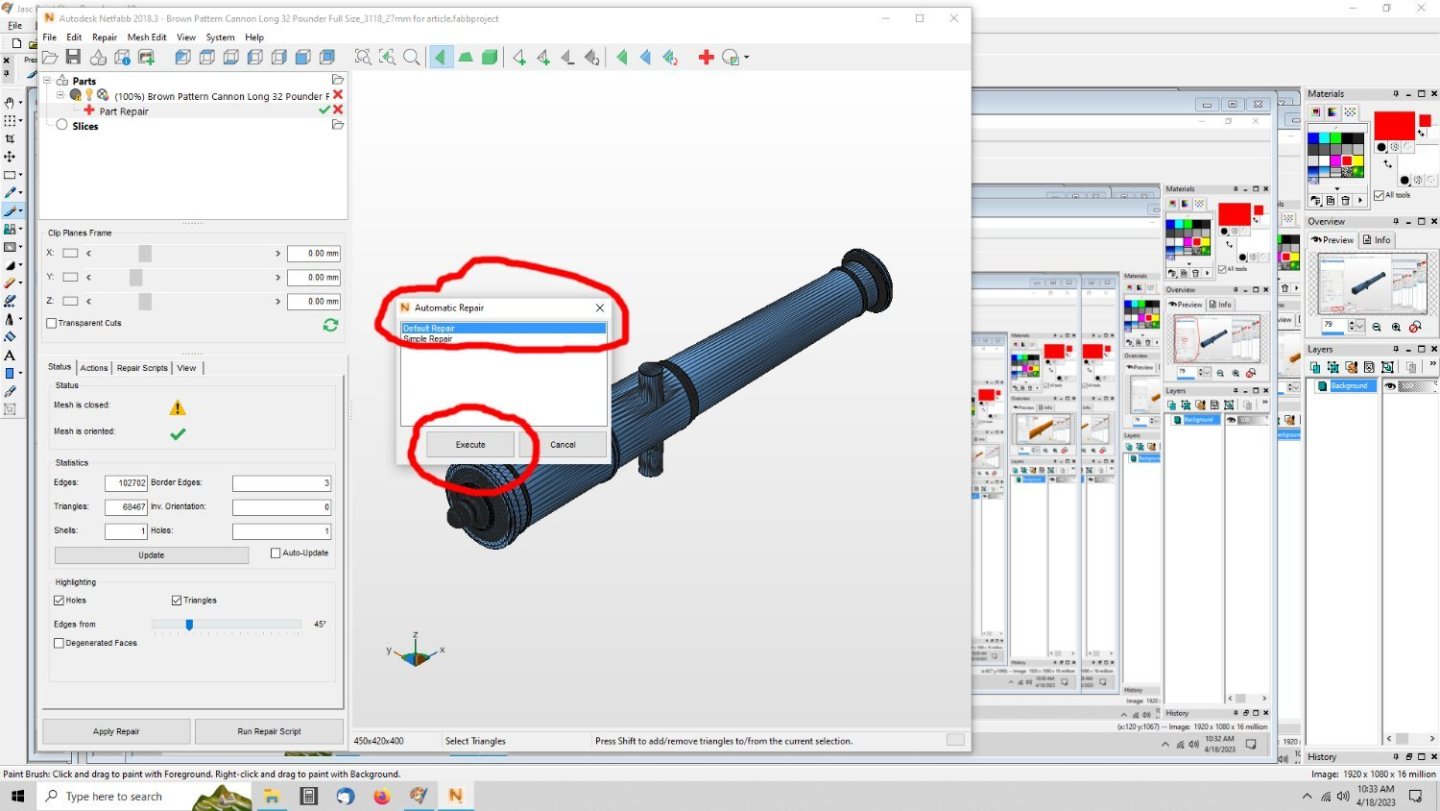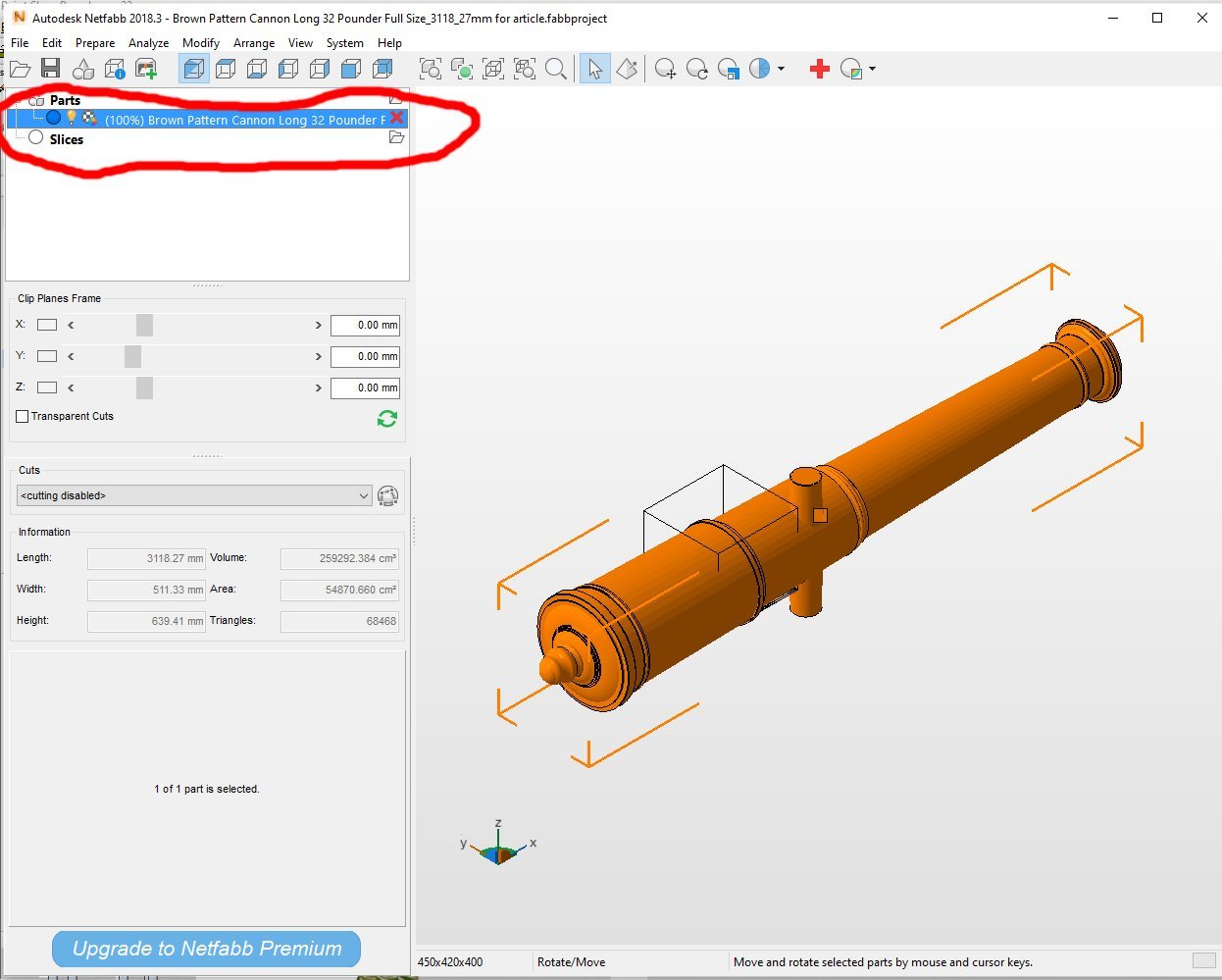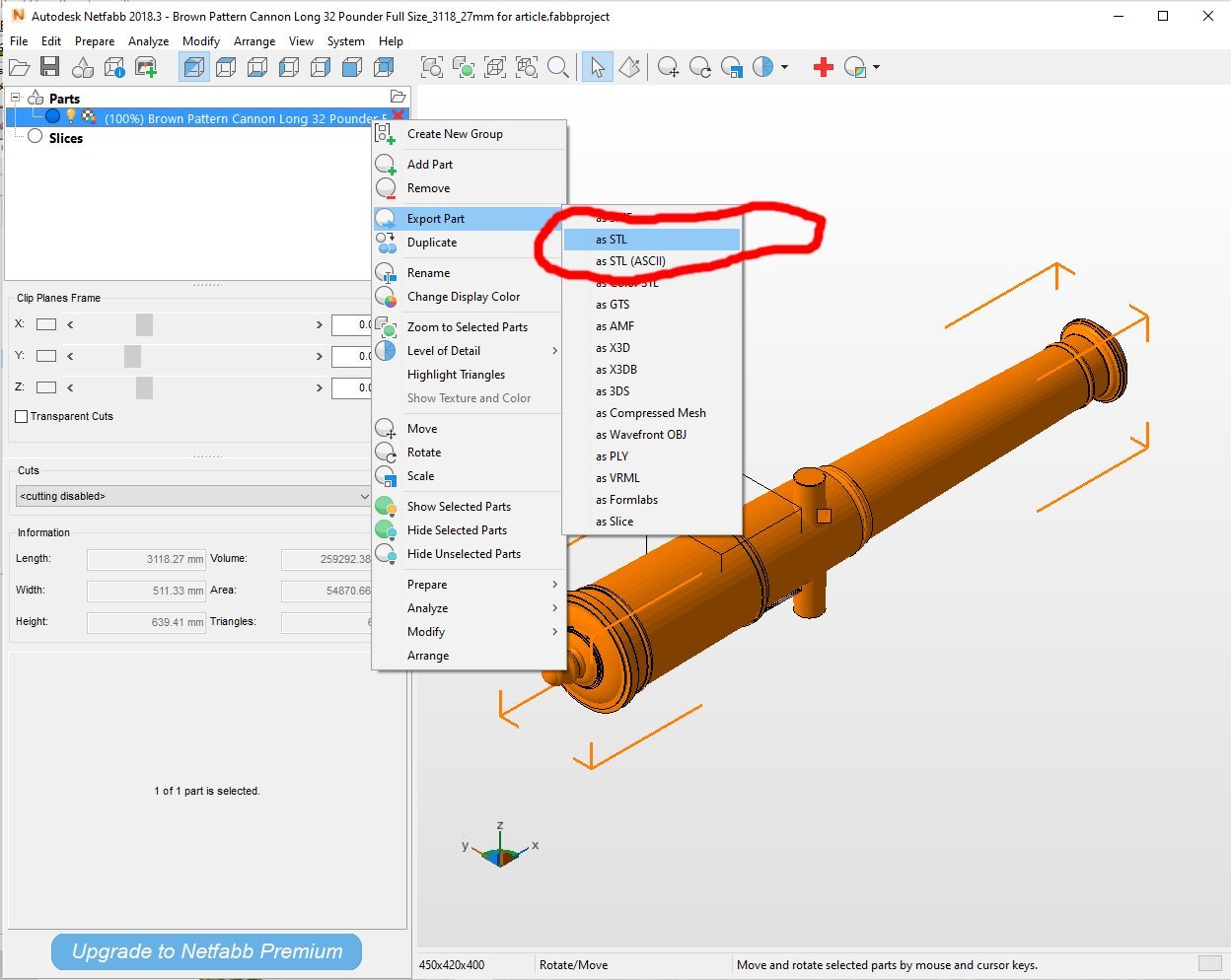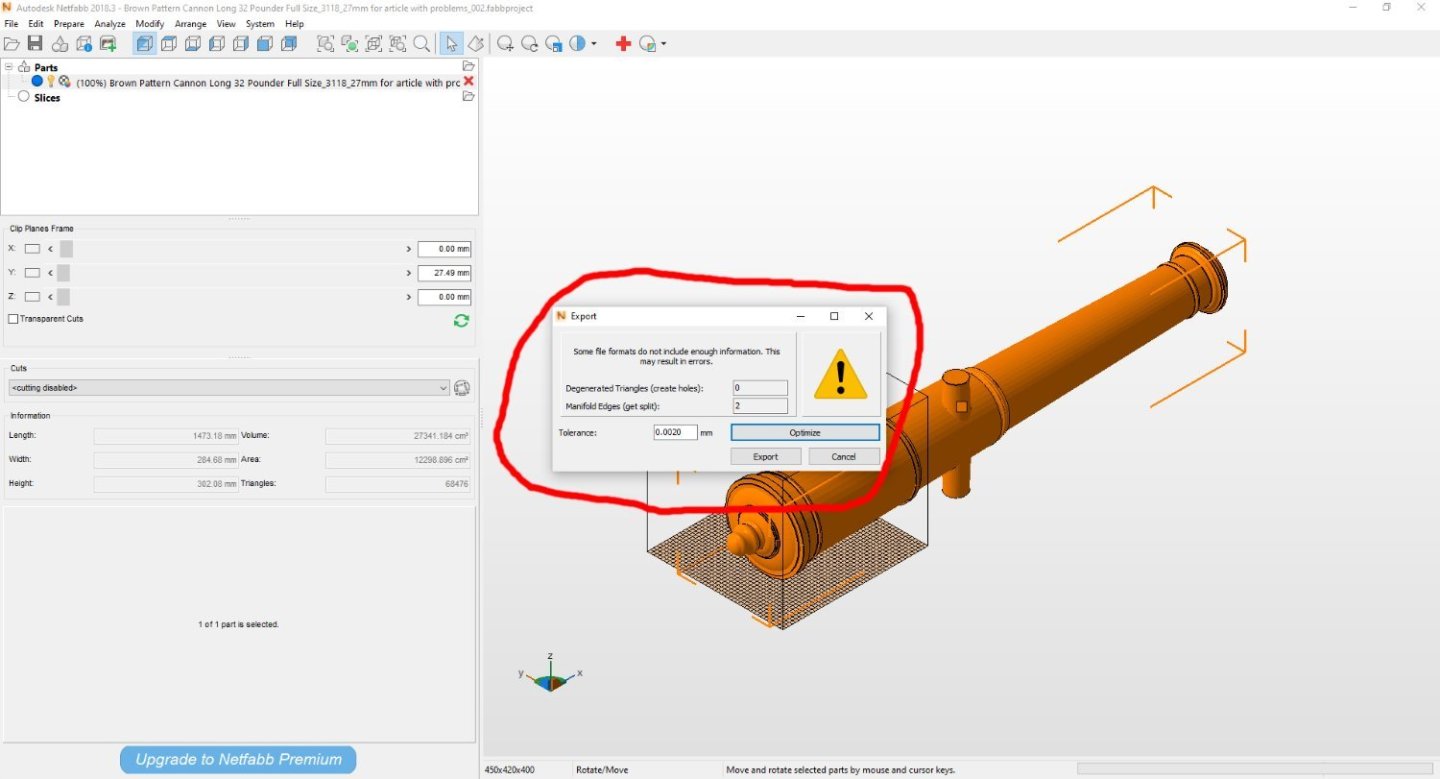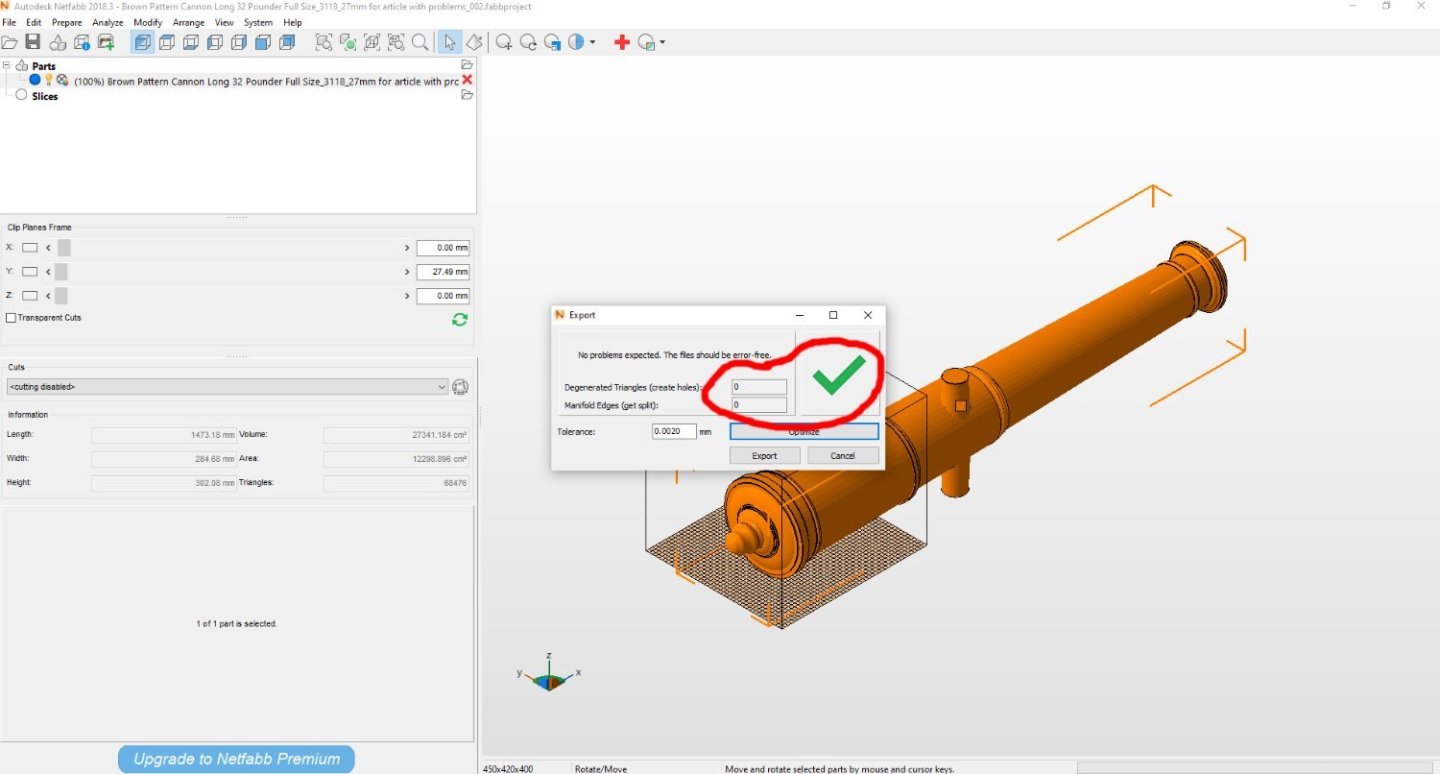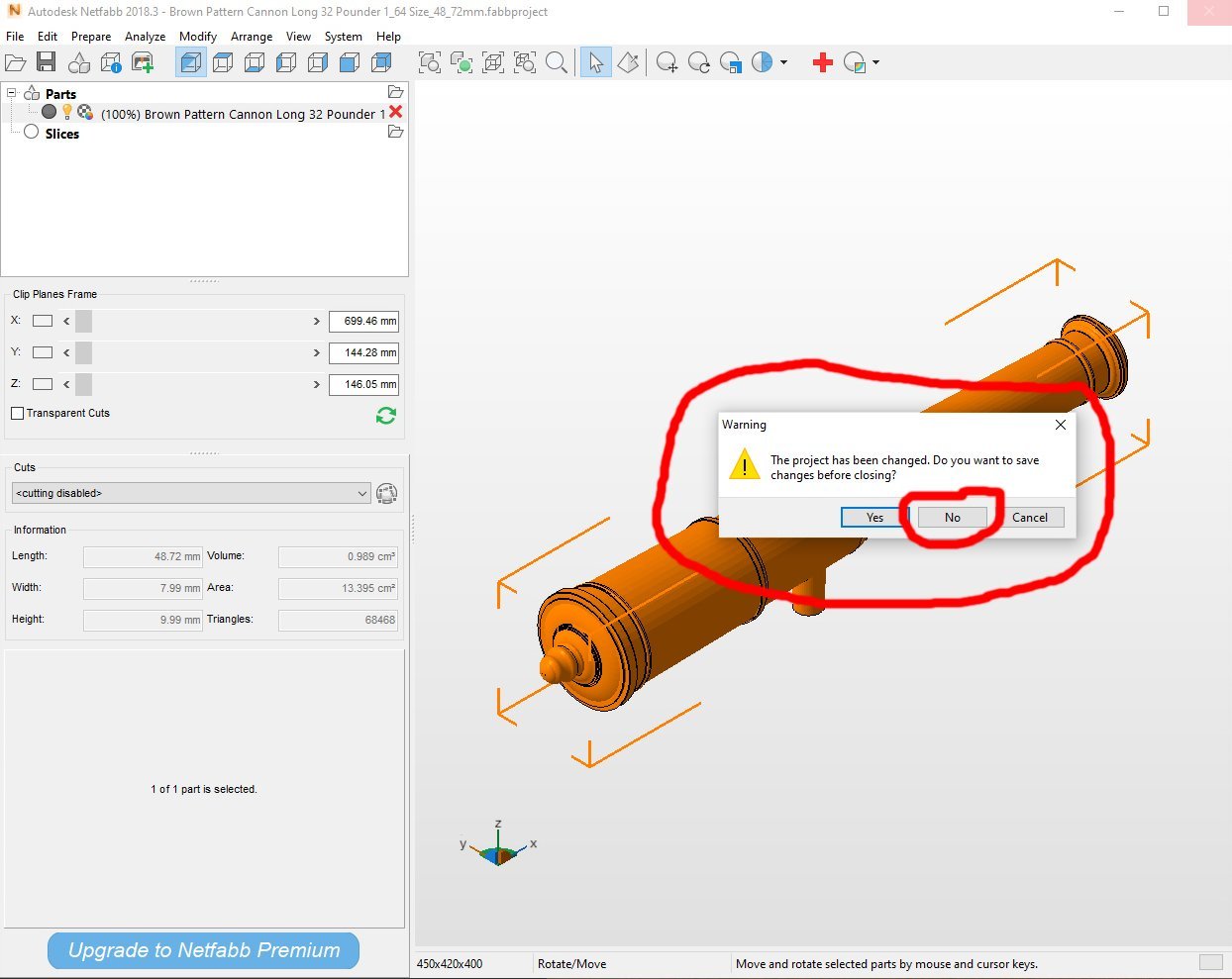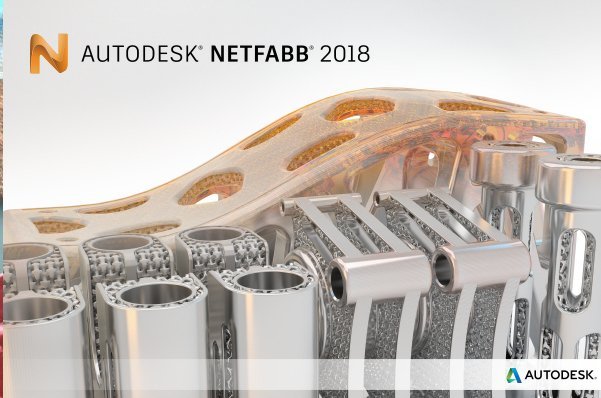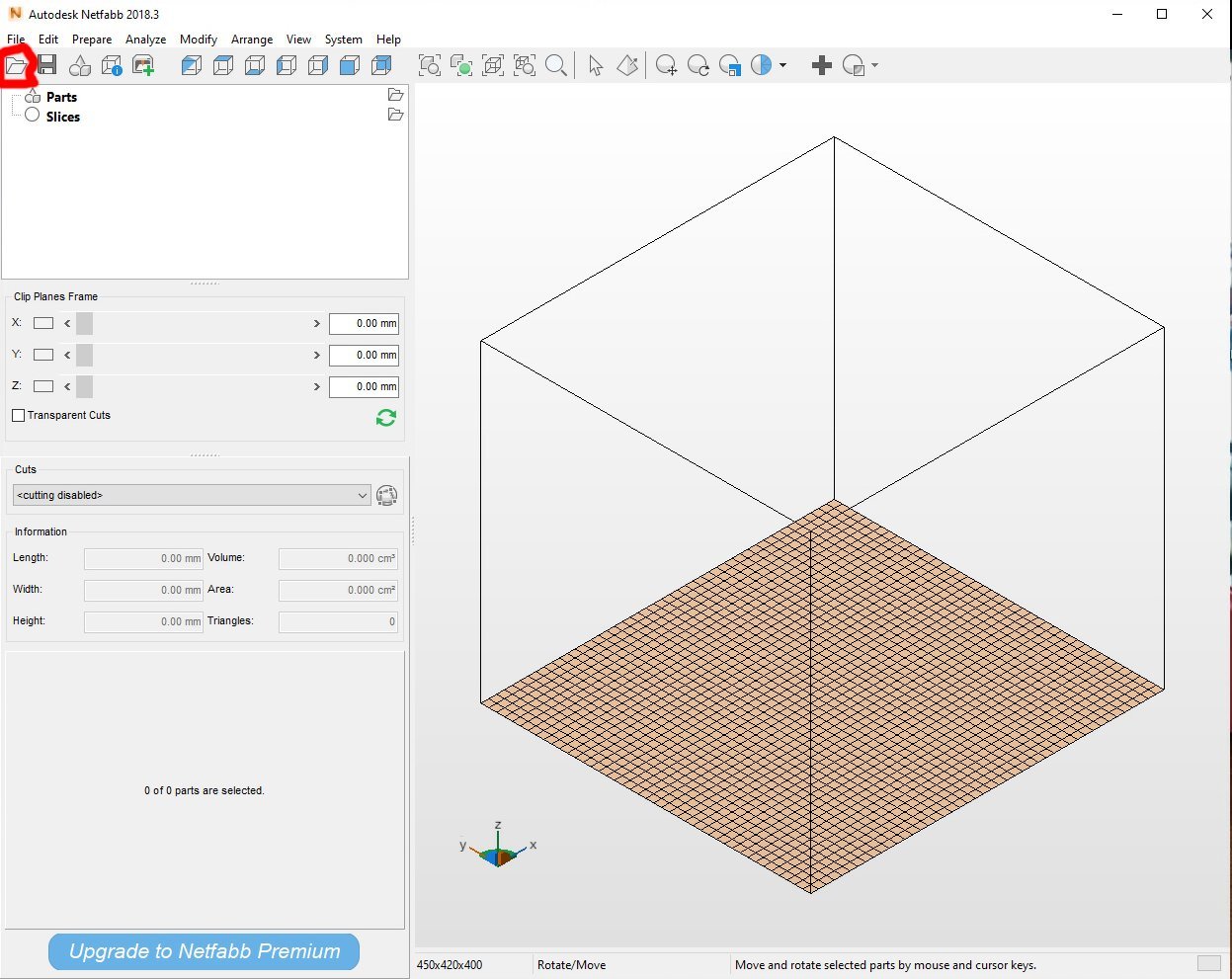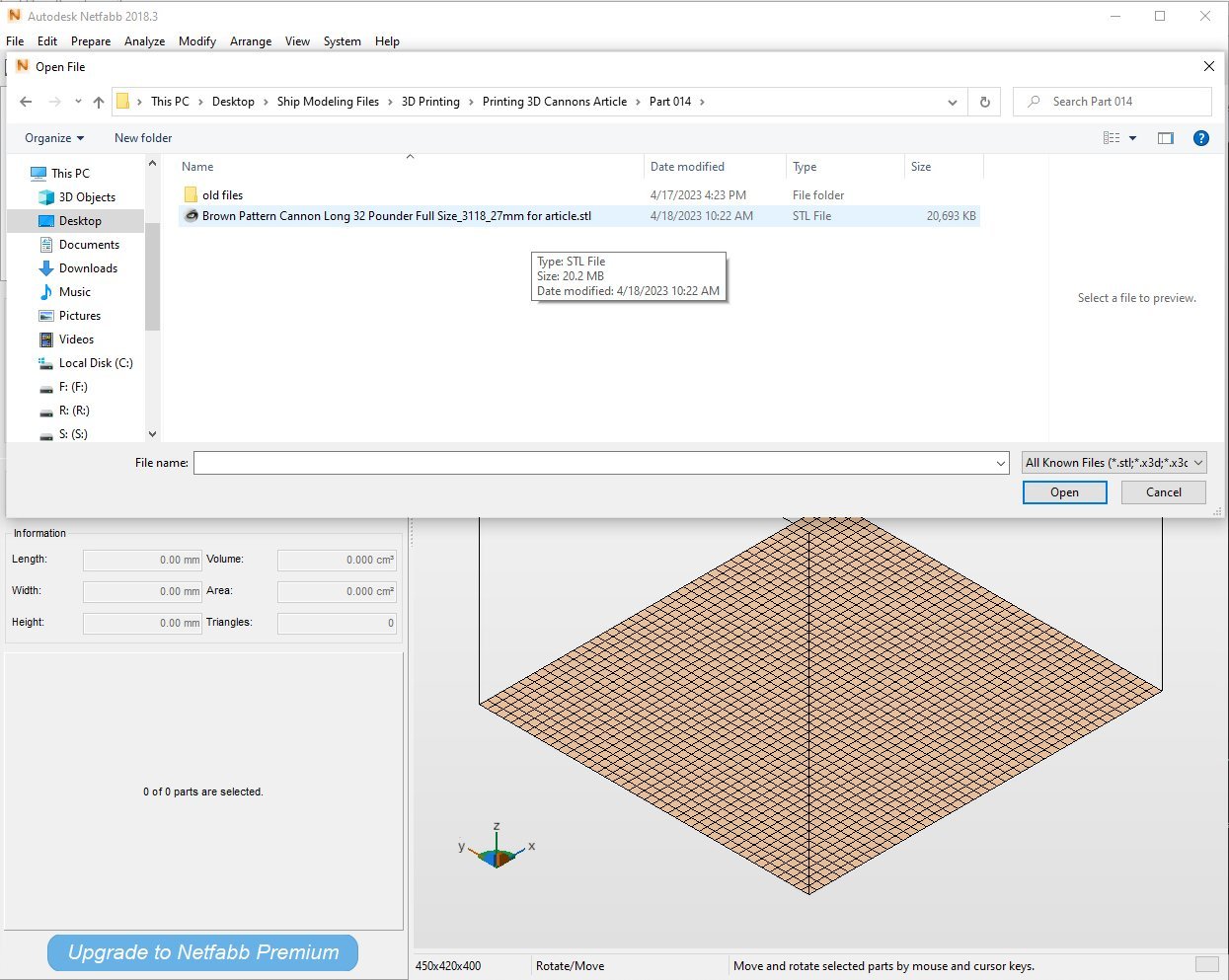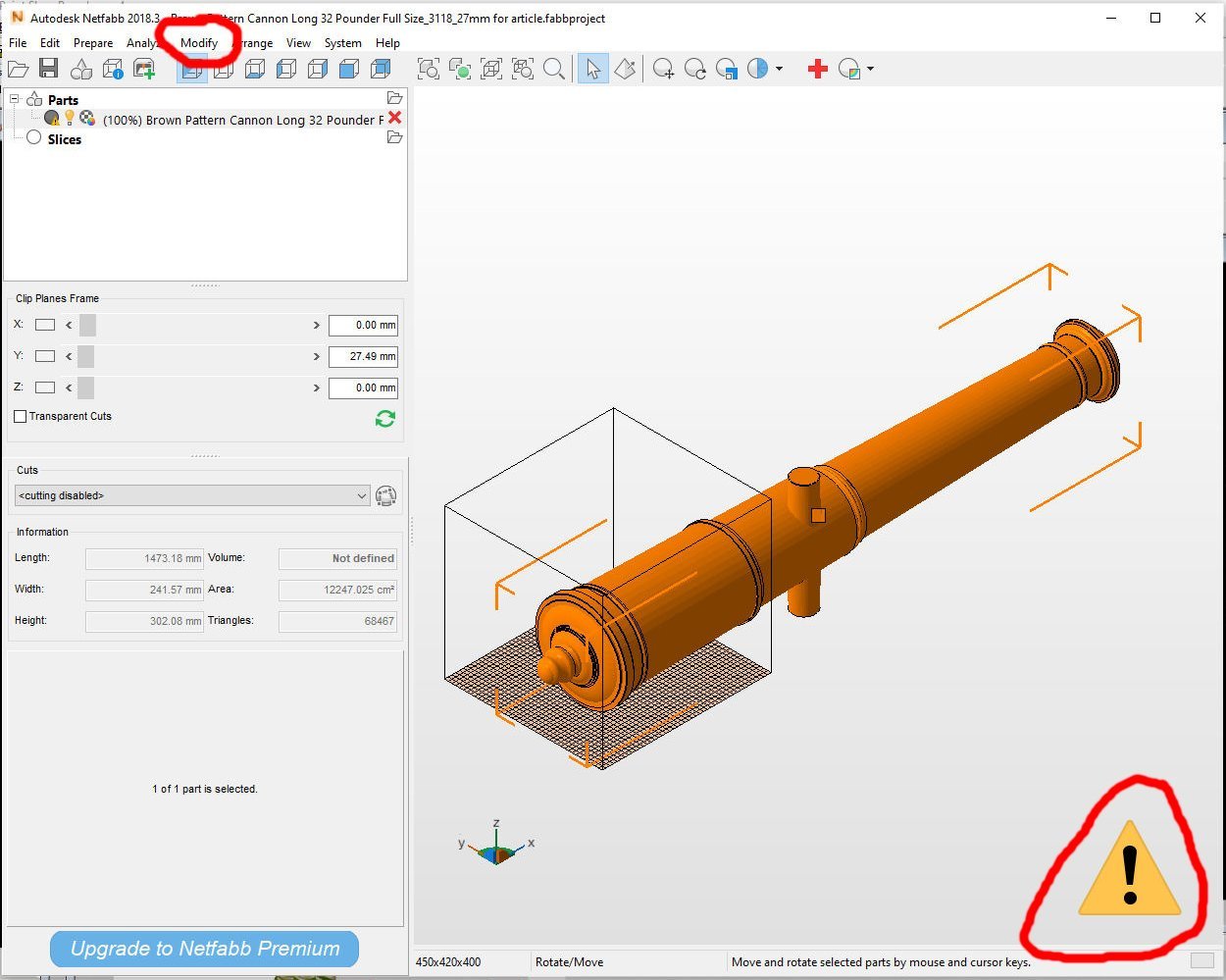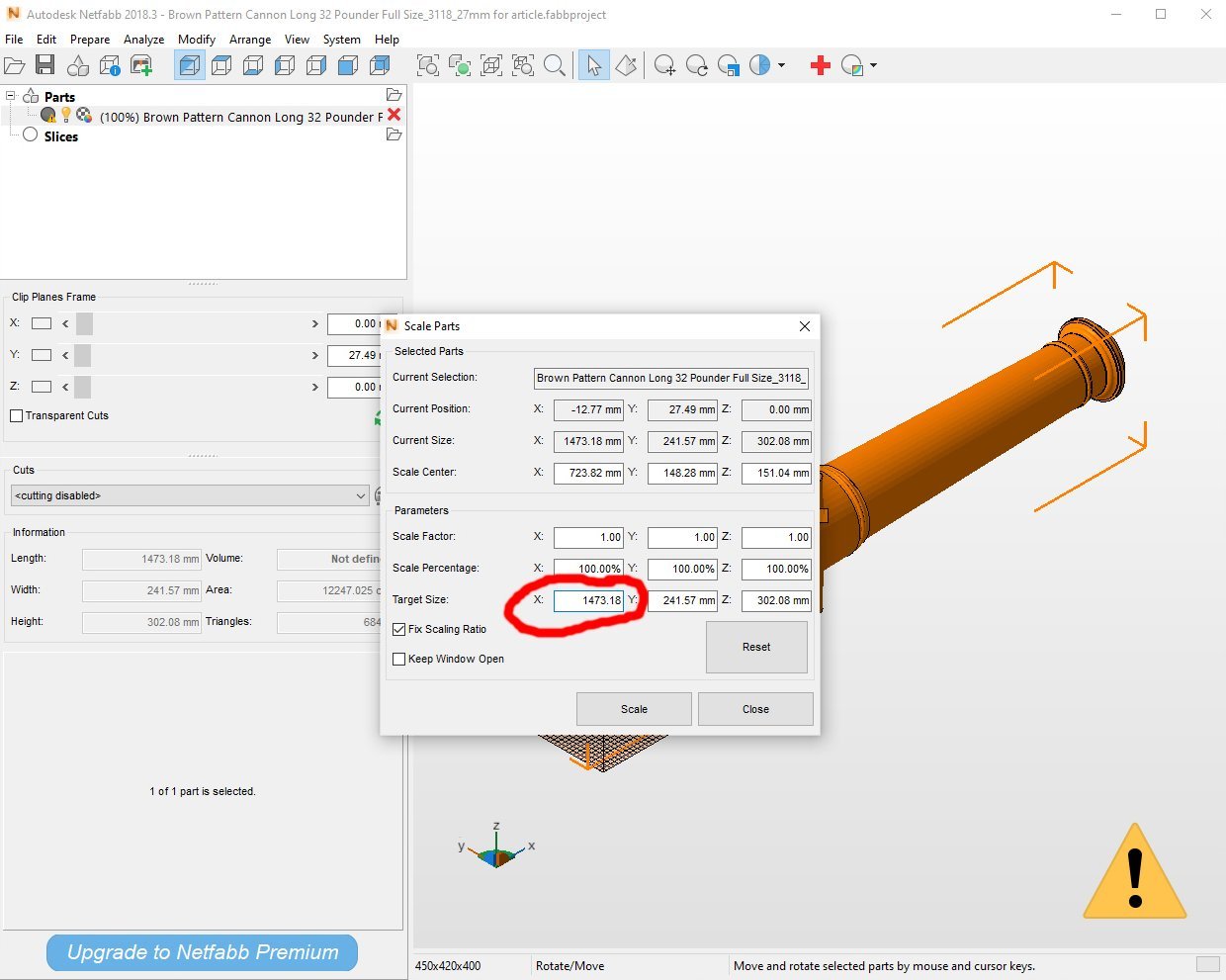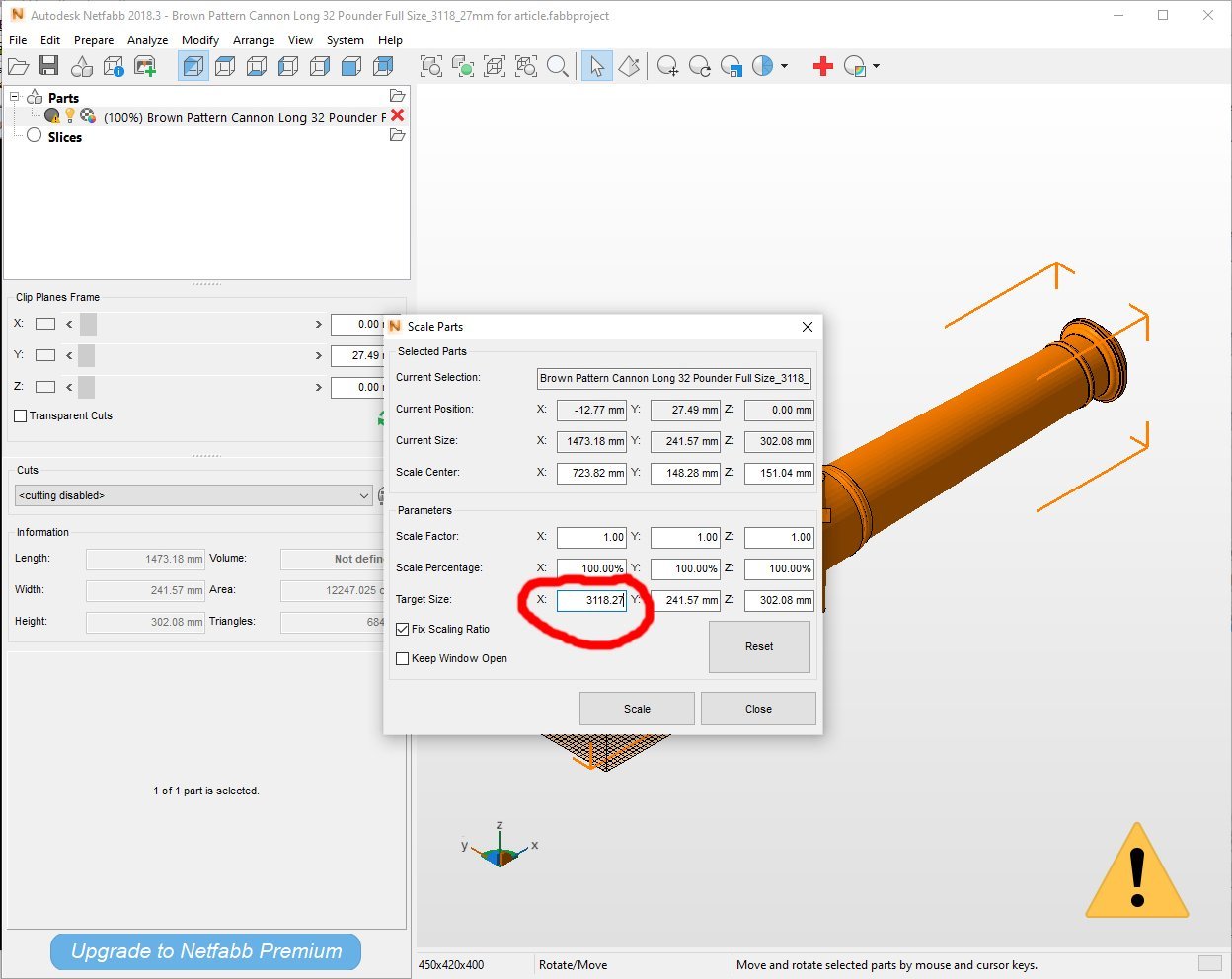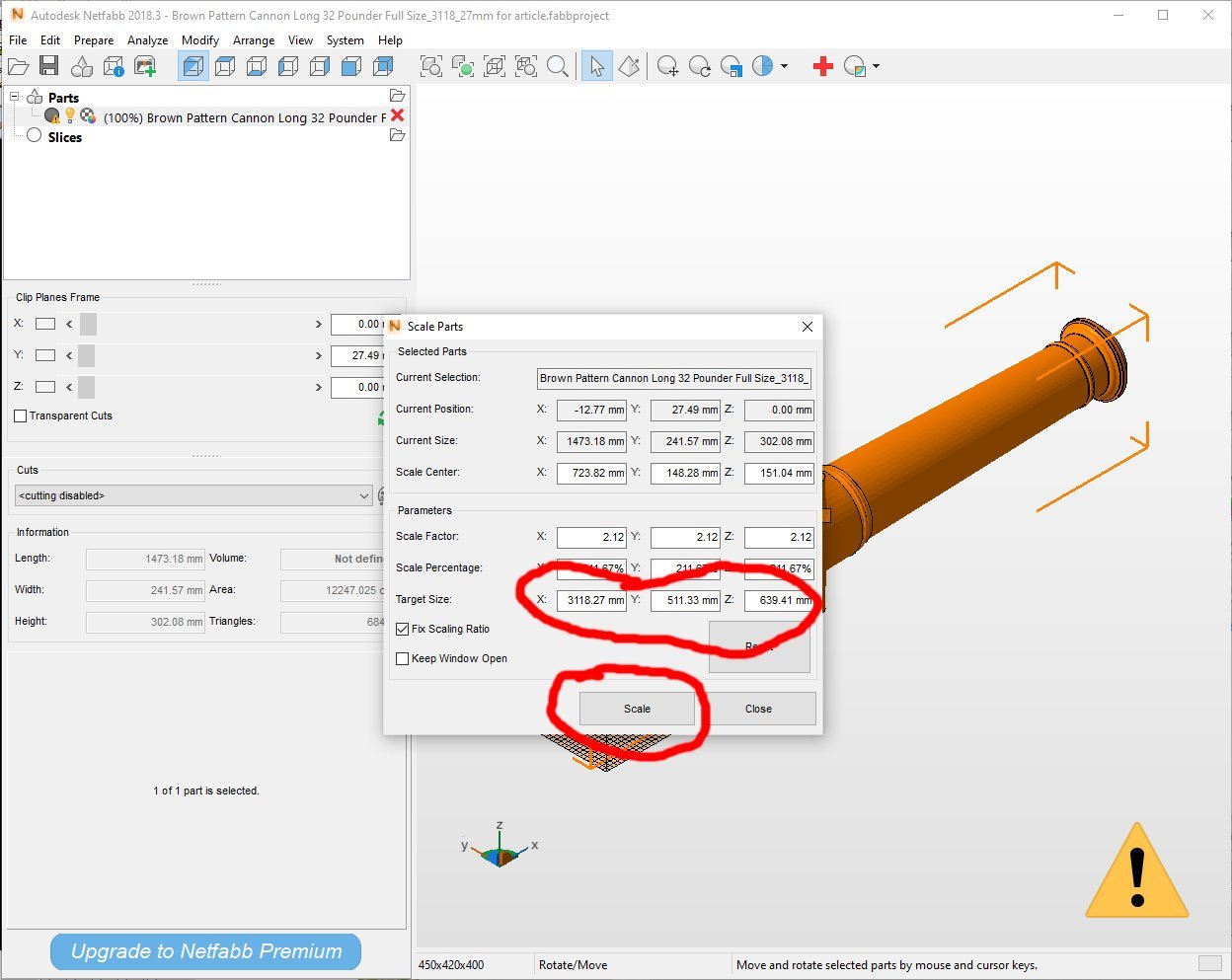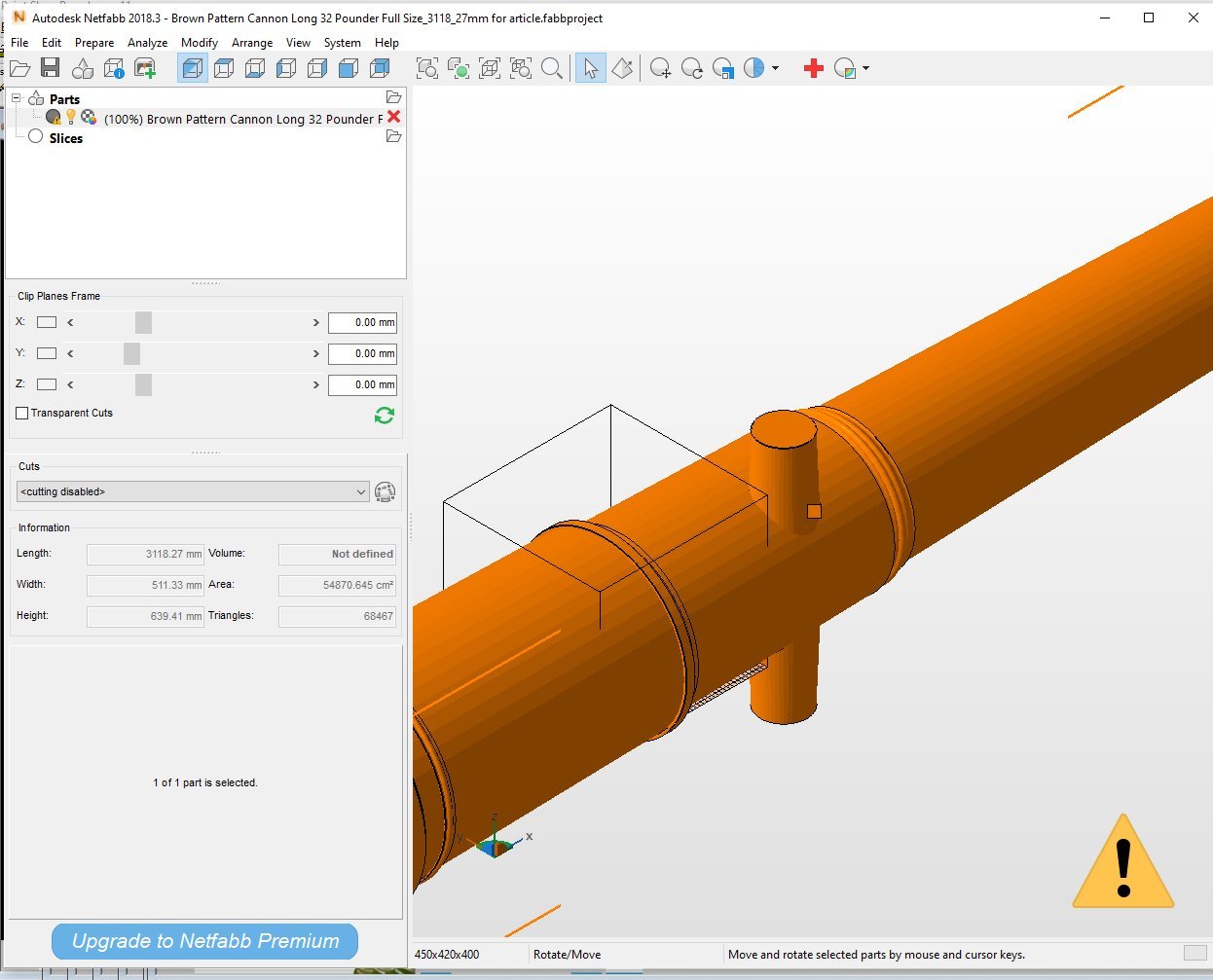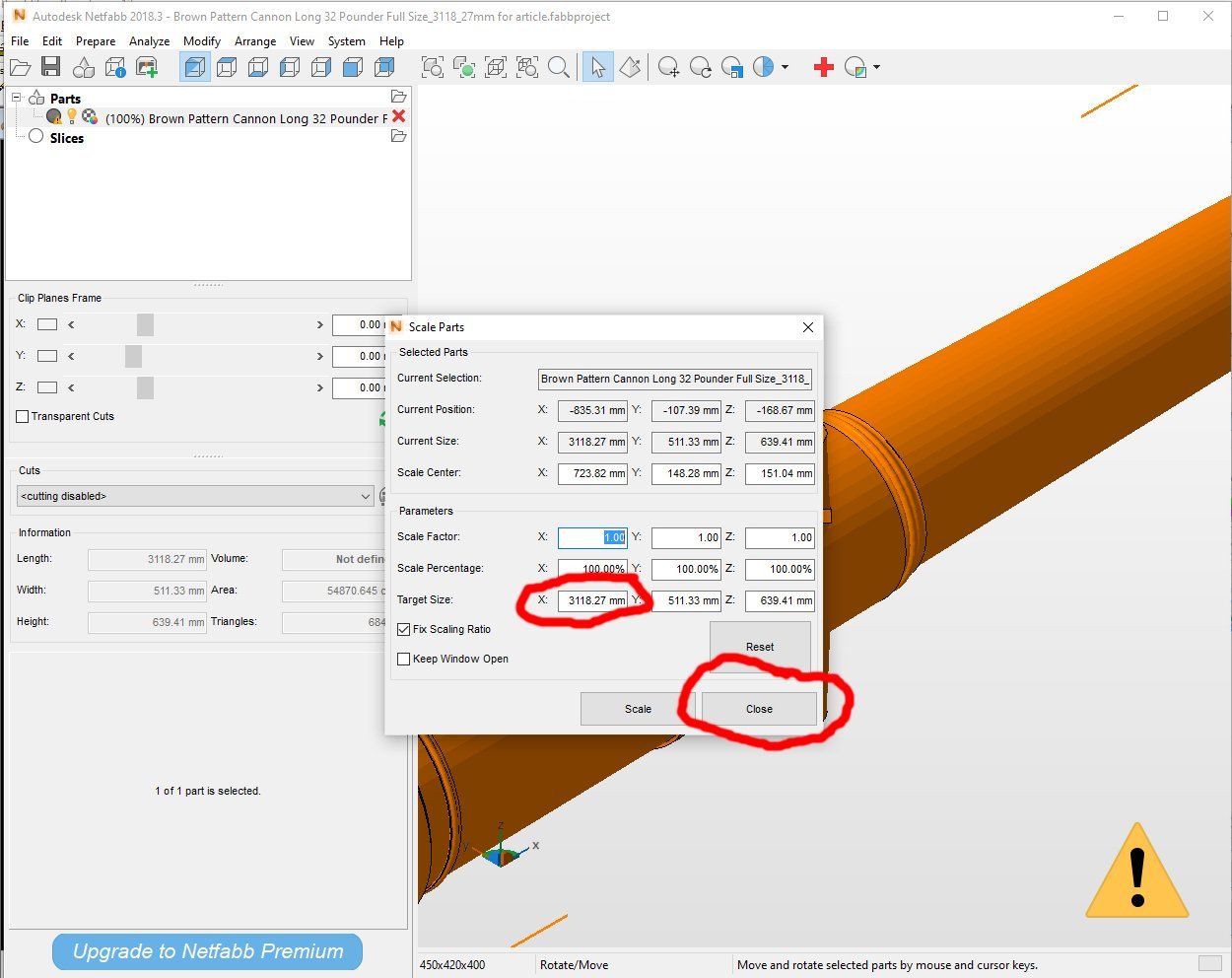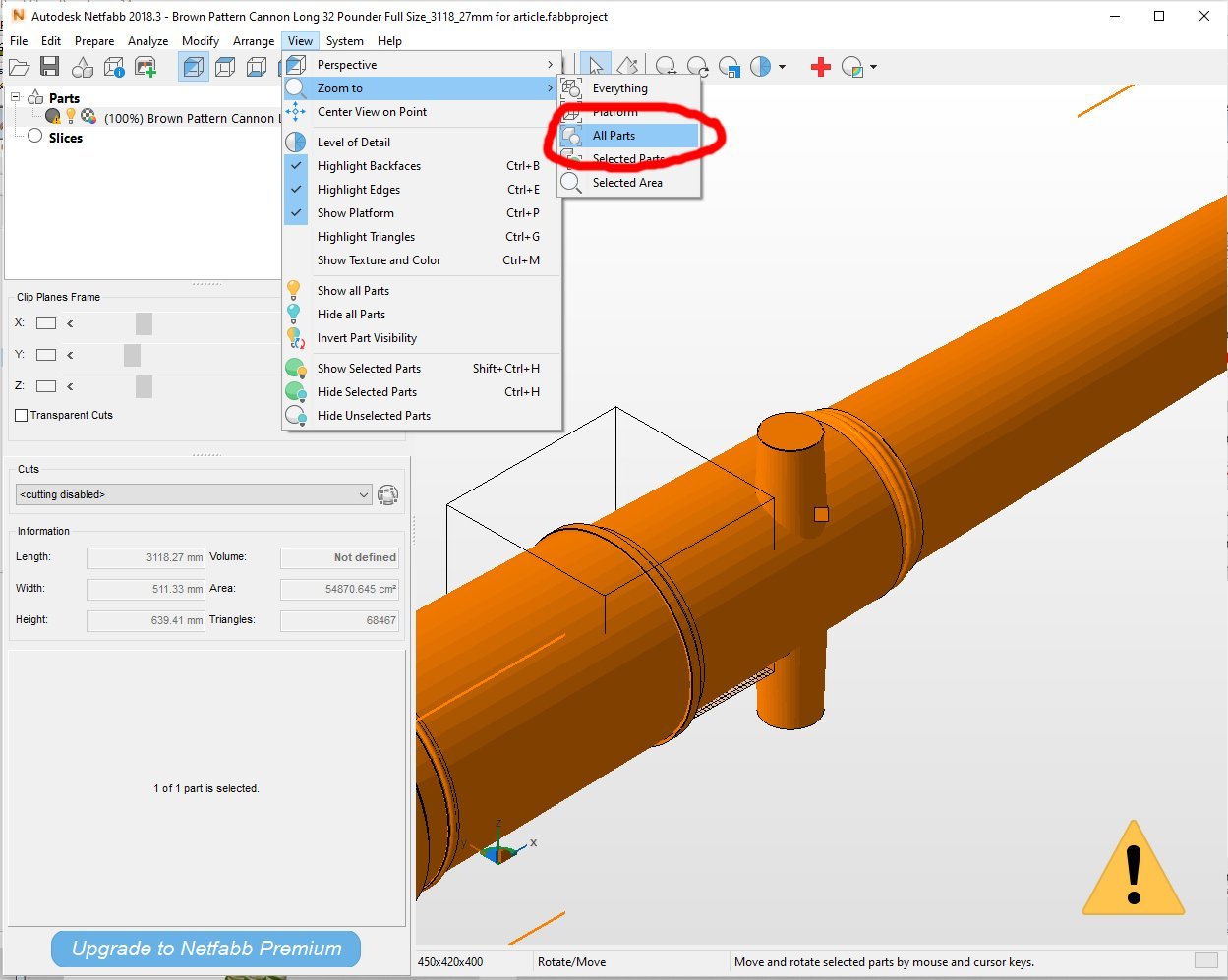-
Posts
2,926 -
Joined
-
Last visited
Content Type
Profiles
Forums
Gallery
Events
Everything posted by thibaultron
-

6-pounder, Royal Navy cannon barrel - George III era
thibaultron replied to Gabek's topic in 3D-Printing and Laser-Cutting.
Here is a SketchUp drawing of the flash pan for the long 24 pounder. Feel free to use it for your 6 pounder. Scaling will be needed, but the general layout is the same. I've included a graphic of the drawing, and a picture of an actual cannon. Flash Pan_003.zip -

6-pounder, Royal Navy cannon barrel - George III era
thibaultron replied to Gabek's topic in 3D-Printing and Laser-Cutting.
Update long 24 pounder STL. This is scaled to full size 3262.31mm. You can scale that to whatever scale you need. I messed up with the first file, by not scaling it properly. My cat escaped and while chasing her, I forgot where I was in a program, and messed it up. This file has been scaled and error checked using Netfabb. Armstrong Fredricks 24 Pounder Long 3262_31mm.stl -

6-pounder, Royal Navy cannon barrel - George III era
thibaultron replied to Gabek's topic in 3D-Printing and Laser-Cutting.
I'm working on a full set of the Fredricks, as well as several other types, in conjunction with Allanyed. I have the long 24 pounder finished for his carriage project. If anyone needs the short one right away, I could generate that one. Otherwise I will finish the Fredrick set after the Blomefields. This is a graphic of the file Here is the STL Armstrong Fredricks 24 Pounder Long 3253_13mm.stl I wrote a thread about setting up for printing cannons in 3D, to help those who wish to try it for themselves. -
I drew up a comparison of the barrel to the carriage, and the drawing is correct. First the drawing with a rough line parallel to the barrel, and center lines on the top view of the carriage. Then I transposed the barrel lines onto the top view. So while the carriage looks overly angular, it is an optical illusion. the angle is correct.
-

6-pounder, Royal Navy cannon barrel - George III era
thibaultron replied to Gabek's topic in 3D-Printing and Laser-Cutting.
Not a wasted effort at all! Good job! -
The printing of the design on a red painted sail will not work at home. No home printer can print white. I relies on the paper, or decal film being white. There used to be a printer that could do this, it used print ribbons with white being one of the ribbon colors. It has been a couple of decades, though, since they made the ribbons, so that option has gone away.
-
Due to family obligations, I have not gotten any further in my modeling. Physical projects at least, I have been doing a few CADing projects.
- 38 replies
-
There should have been a roll of plans showing each assembled frame in scale. I scanned each frame and used the prints of each as a pattern when assembling them.
- 38 replies
-
I was thinking more along the lines of using a 4 jaw chuck. setting the screw ends against the chuck face, to index the nut so the top machined surface would be facing out. Tightening the jaws, then machining the top surface. You could loosen two jaws, check the fit, and then return the nut to the chuck, without losing the setup. You would have to remove the screw, between checks and reinstall it. If the jaws are too tall, make up a spacer to fit firmly between the chuck face and the screw. If milling the part, use parallels under the two ends of the screws.
-

Elementary school clear glue?
thibaultron replied to modeller_masa's topic in Modeling tools and Workshop Equipment
The trouble with the Washable glues, is that they do not hold well. -

3D Printing Cannons in Resin
thibaultron replied to thibaultron's topic in 3D-Printing and Laser-Cutting.
Nice metalworking program you have there! Glad you like the thread! -

3D Printing Cannons in Resin
thibaultron replied to thibaultron's topic in 3D-Printing and Laser-Cutting.
Part 17 This section will cover what happens if Netfabb finds major errors with your STL file. If you have gotten a STL or OBJ file from a third party, these types of problems should not be a problem for you. If, like me, you are working on a file you created, the problems below, can occur. These are problems like holes or extra things, that make no sense in a real object. For this section I created a file that had two major problems. The first problem is that I deleted a small surface, so that the model had a hole in the outer skin. The second problem is a zero thickness tab hanging off the model. The tab is simply a sheet with no thickness. This can happen when you are editing a 3D object, and miss a small area that should have been deleted. In this example, it is easily spotted for correction, but sometimes they are so small, the you might miss them without a highly magnified surface scan of the original model file. After you open the STL and select the Red Cross symbol, your model will be displayed in blue with yellow error markings. You can zoom in to look at these areas using the mouse wheel, and rotate around the model by holding down the right mouse button. I ran the repair script, and after I replaced the old part, there was still a problem! Netfabb did not remove the tab! It seems the program sees this as a valid object. You will have to go back and delete it from the original drawing. This should only be a problem if you are creating your own models. If Netfabb has found problems like this with one of my drawings, I rerun the repair script again to make sure that there are no artifacts like this tab left, after the first attempt. Naturally, it still shows this obvious fault, but if this had been a small one, I might not have noticed the problem, without the second check. We will continue as if the tab is alright, for now. After the first repair run this screen was displayed. We will now save the file, and see if the second check will fix this. It says it fixed something. I opened this STL file in Lychee. No, the tab is still there! I would have to go back and fix this in the original drawing. I reran the original bad file to show you what the tab looks like after running a second Repair Script, and the program displayed the problem differently. Instead off highlighting it in yellow, it displayed it as red and green, with question marks in the script screen. Here are a couple of graphics of different ways this error was displayed when I was doing this write up. I hope this thread has helped you on your way to 3D printing! -

3D Printing Cannons in Resin
thibaultron replied to thibaultron's topic in 3D-Printing and Laser-Cutting.
Part 15 Now we will perform the Error Correction Routine. Select the “Red Cross” button. I do this with every new model, even if no warnings are displayed. The error screen will be displayed at the lower left. There are a few symbols that might be shown. A green checkmark means that particular parameter is good. A warning symbol means errors. There may also be a blue question mark, meaning it is not sure. The model will also be displayed in blue. If there are yellow markings displayed on the model, there are gross errors. I’ll cover them in Part 17 of the postings. Even if it shows all check marks, I run the repair script anyway, just to be sure. Select the “Run Repair Script” button. A new pop up will be displayed. I leave it on the “Default Repair” setting. Select the “Execute” button. If you look at the very bottom right of the window, you will see a little white rectangular box. This is the progress bar, and a green line will fill it from left to right as the repair script runs. When the bar fills the space, the script is finished, and the bar will disappear again. So watch it, to make sure the script ran. For this simple model, the script finished too quickly for me to get a screen shot of the bar. When it is finished, we now have to replace the old model with the repaired one. Select the “Apply Repair” button. This pop up will be shown. Select the “Remove old Part” button. The part correction will be applied, and the model will once again be displayed in orange. Now we need to save the corrected model. Right click on the blue bar under the “Parts” window. The name in it will change for each model you work on. Select “Export Part”, then “as STL” Now before you select the “Save” button!!! Look at the default name the program has selected for the file! Most of the time, it will duplicate the original file name twice, in the new file name! For example, "Cannon 25 – Cannon 25(repaired).stl", rather than "Cannon 25(repaired).stl". I have found Windows 10 unwilling to let you correct this file name if Netfabb saves it this way. I think it is because of the “-“ symbol, which is normally not one Windows likes in a file name. Go into the file name and delete the second extra text. If this will be a unique file, no rescaling, not going to be sent to someone, etc., I generally leave the “(repaired)" text in the file name, just because it differentiates it from my original STL file. I like to keep previous versions of my files as a design progresses. If I am going to be rescaling, it or otherwise renaming it, I delete the “(repaired)”. Select “Save” after you have made any changes to the default name. Before it saves the file, the program runs a final error check on it. This second check looks at different parameters than the first one, and may find some problems, it wants to know if you would like corrected. You can choose to ignore them, and continue. I always choose to let the program go ahead and fix these, after all, we are running Netfabb to fix any errors it finds. If errors are found this window will pop-up. Select “Optimize” to let it try to fix these errors. Otherwise, select “Export” to ignore them. If Netfabb can correct these problems, you will get this pop up. The check mark signifies all the errors were fixed. Select “Export” to save the file. Netfabb will, most times, fix all these errors, but sometimes there are a few left. No matter how many times you try to optimize these last errors away, Netfabb just can’t correct them. I just go ahead and export the file, with the uncorrected errors, and have had no problems. These are minor problems compared to those found in the repair script. I don’t have a screen shot of this, as it happens infrequently, and there were no instances while I was writing this, to get a screen shot from. You will be brought back to the main screen, and can now exit the program. It will ask you one more question, before it quits. It asks you if you want to save this project. The is no real reason we need to, so I just select “No”. Part 16 To rescale the cannon, simply repeat the above, but entering the correct scale length for your models. I always go through the entire error checking process, every time I rescale a model. When you rescale something, some scaling errors can creep in do to software decimal place limits, so checking and correcting these is a good idea. You should be able to print an unrepaired file with no problems, if you started with a clean master, but this only takes a few minutes, so why not be safe. -

3D Printing Cannons in Resin
thibaultron replied to thibaultron's topic in 3D-Printing and Laser-Cutting.
Part 14 Netfabb is a program from AutoCAD that allows you to perform many operations on both STL and OBJ files. I will cover error checking, repair, and scaling. The scaling will cover both correcting you file to the correct dimensions, and rescaling an existing STL or OBJ to a different scale. This will take 3 posts, as there are a lot of graphics, as I go through using Netfabb step by step. In actual life it only takes 10 minutes or so from start to saving the new version of your STL, unless you have a majorly complex model. Netfabb is available as a download at: https://www.autodesk.com/products/netfabb/free-trial I’m using Netfabb 2018. For my version, after the trail period, they would ask you for a license number. If you just exit out of that window, they will ask you if you want to continue with the unlicensed version, select “Yes”, and you can continue to use it. Every now and then, that same window will pop up, and I repeat the procedure. As long as you are not using the program for commercial use, it is legal to use it. The first part of this section is importing your STL to check that it comes up the right length. In this case I am importing a STL for a full size 1:1 cannon I drew. Following that I will run through an error checking and correcting sequence. When Netfabb is opening you get this splash screen, at least in my version. The program then opens this window. This is the default size of the window, you can expand it to full screen size, like any Windows program. Select the file folder symbol under the “File” menu icon to open your STL or OBJ file. For files like this I like to include as much information in the file name as possible. This is so a few years down the line, I will remember what the h..l I was doing! In this case I put the full description of what cannon it is, the scale (Full Size = 1:1), and the total length to aid in rescaling in the future. In this case, the “for Article” is because I modified the file specifically for the examples in this write up. Wouldn’t want to get this modified file mixed up with the original. The program opens and displays the file. The program found possible errors in the file, as denoted by the warning symbol, in the lower right hand side. We will check these further down. Right now, I first check that the model is the correct length, not a given with the SketchUp version I use. Select the “Modify” button. Select the “Scale” button. The “Scale Parts” window will open, displaying the dimensions of the model. In this case we can see that it is incorrect. The length should be 3118.27mm for 1:1 scale, not 1473.18mm. I selected the “X” box, deleted the existing number (this is required, or the program will mess up), entered the new value 3118.27, and clicked on another box. The dimensions corrected on all the axis. Then I selected “Scale”. The changes are made and the now larger cannon model is displayed. I then repeated the scaling process, to insure that the dimension numbers were correct. Netfabb sometimes slightly changes the entered values, so I always recheck that the scaling came out correctly. If the numbers are different I correct the “X” axis number and resave. Generally it comes out correct the second time. Sometimes no matter how much you try to correct the value, it still comes out with a slightly different value in the second decimal place. I just except it and continue. If you wish, you can change the window to display the whole model once again. Select the “View” menu button, then “Zoom to”, and then “All Parts”. The model will now once again be fully displayed in the window. -

Failed print but also not fine enough detail
thibaultron replied to Srenner's topic in 3D-Printing and Laser-Cutting.
I use Netfabb to check my STL files. It works with OBJ files also. -

Failed print but also not fine enough detail
thibaultron replied to Srenner's topic in 3D-Printing and Laser-Cutting.
For a 40um layer 90% exposure. As far as alias questions, I don't know. My machine will not do that, so I've never investigated it.
About us
Modelshipworld - Advancing Ship Modeling through Research
SSL Secured
Your security is important for us so this Website is SSL-Secured
NRG Mailing Address
Nautical Research Guild
237 South Lincoln Street
Westmont IL, 60559-1917
Model Ship World ® and the MSW logo are Registered Trademarks, and belong to the Nautical Research Guild (United States Patent and Trademark Office: No. 6,929,264 & No. 6,929,274, registered Dec. 20, 2022)
Helpful Links
About the NRG
If you enjoy building ship models that are historically accurate as well as beautiful, then The Nautical Research Guild (NRG) is just right for you.
The Guild is a non-profit educational organization whose mission is to “Advance Ship Modeling Through Research”. We provide support to our members in their efforts to raise the quality of their model ships.
The Nautical Research Guild has published our world-renowned quarterly magazine, The Nautical Research Journal, since 1955. The pages of the Journal are full of articles by accomplished ship modelers who show you how they create those exquisite details on their models, and by maritime historians who show you the correct details to build. The Journal is available in both print and digital editions. Go to the NRG web site (www.thenrg.org) to download a complimentary digital copy of the Journal. The NRG also publishes plan sets, books and compilations of back issues of the Journal and the former Ships in Scale and Model Ship Builder magazines.



